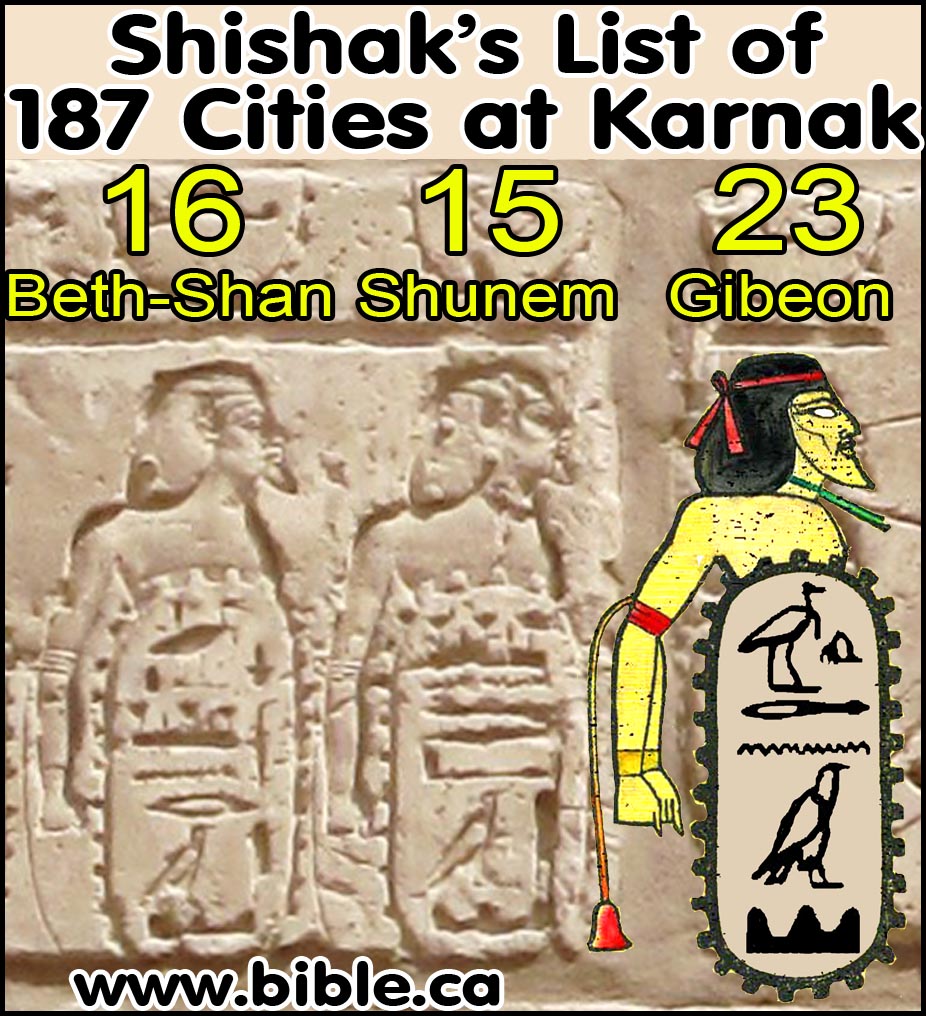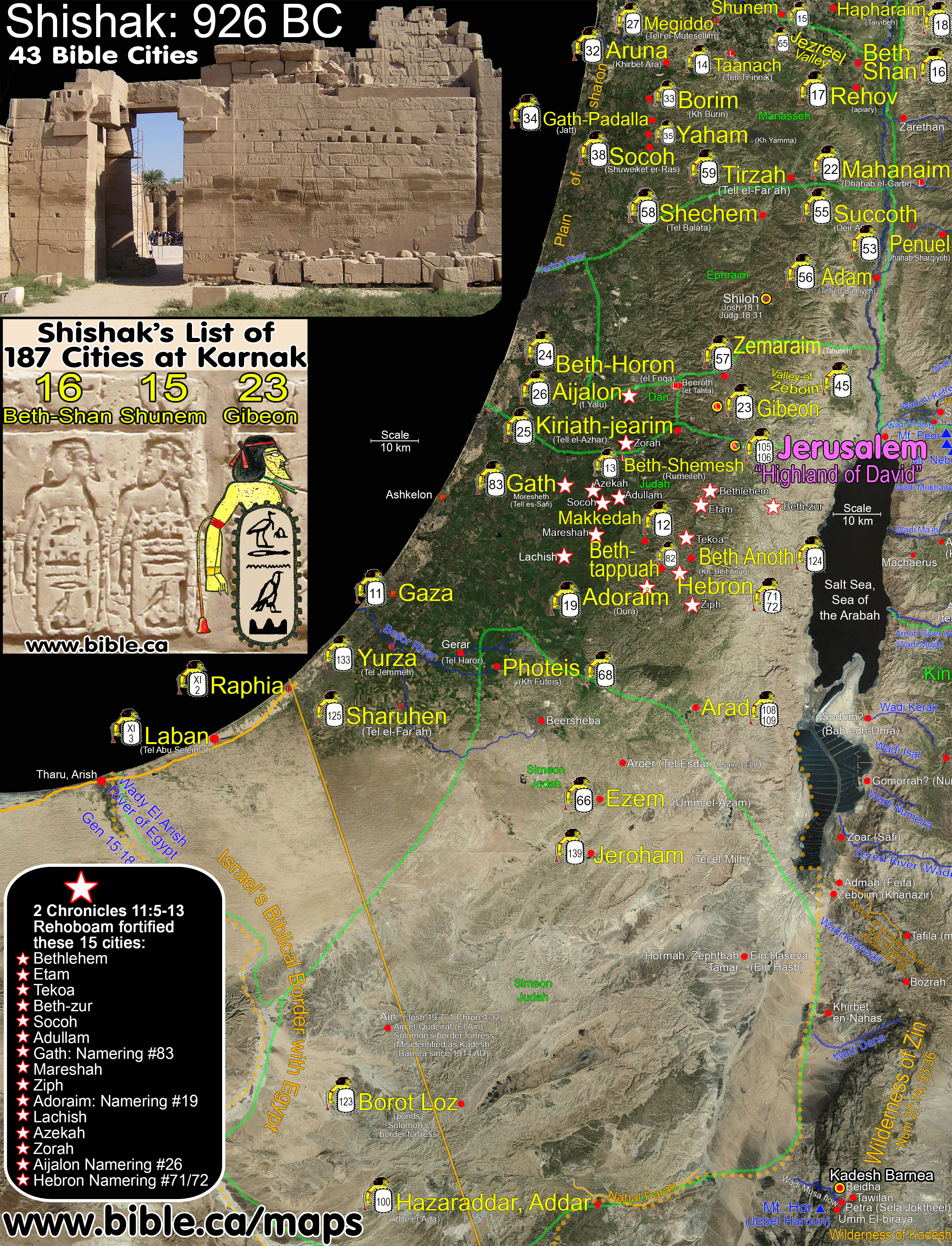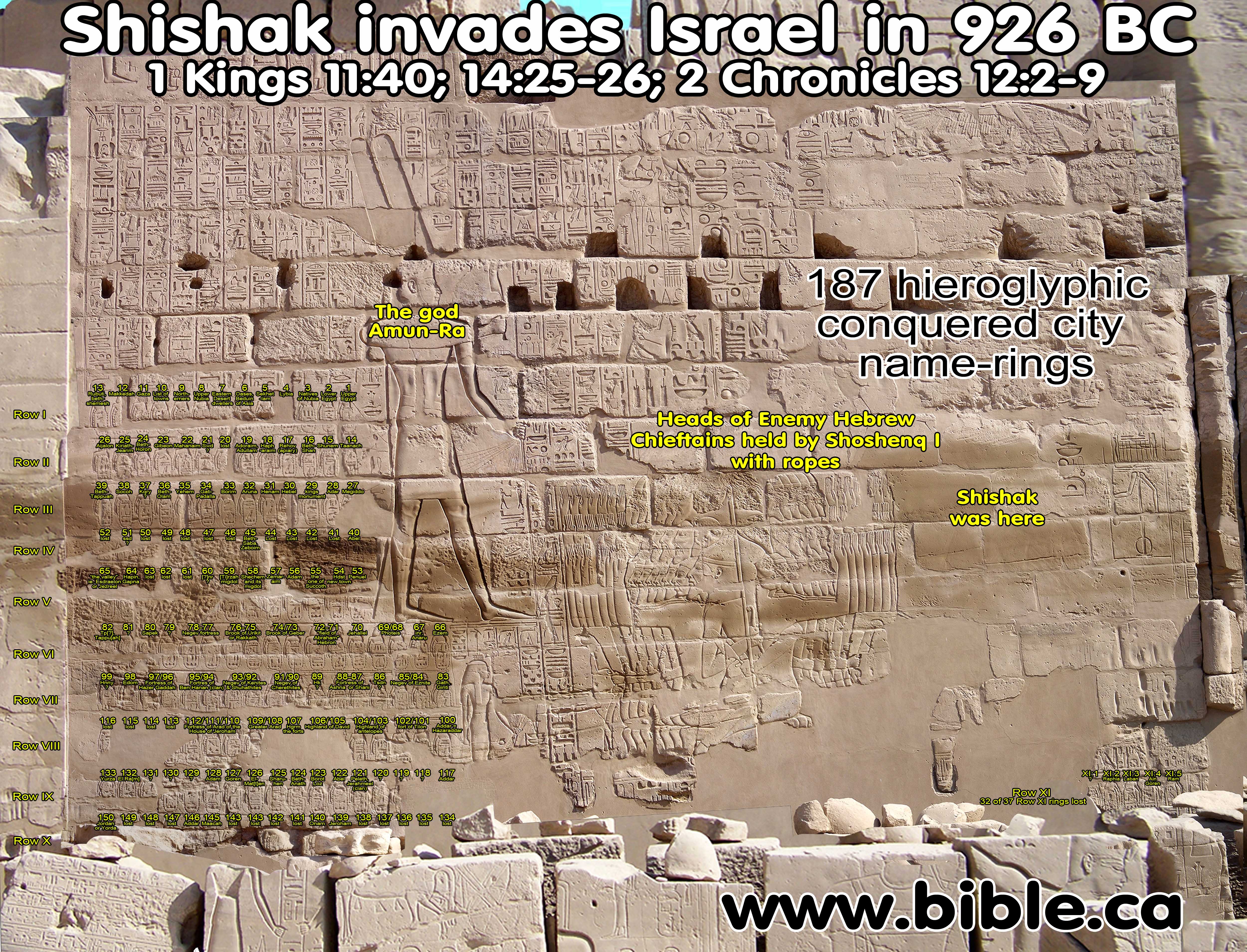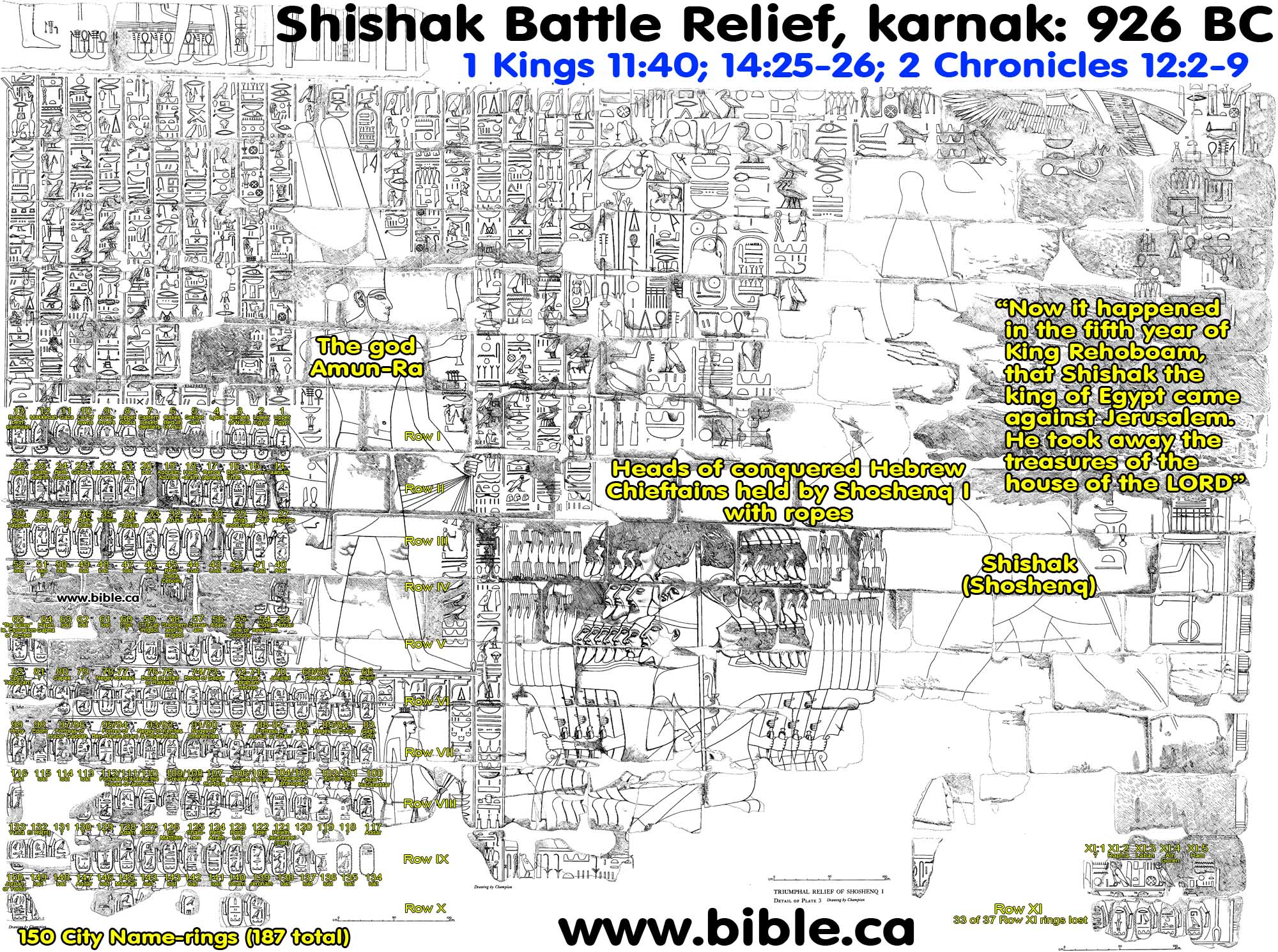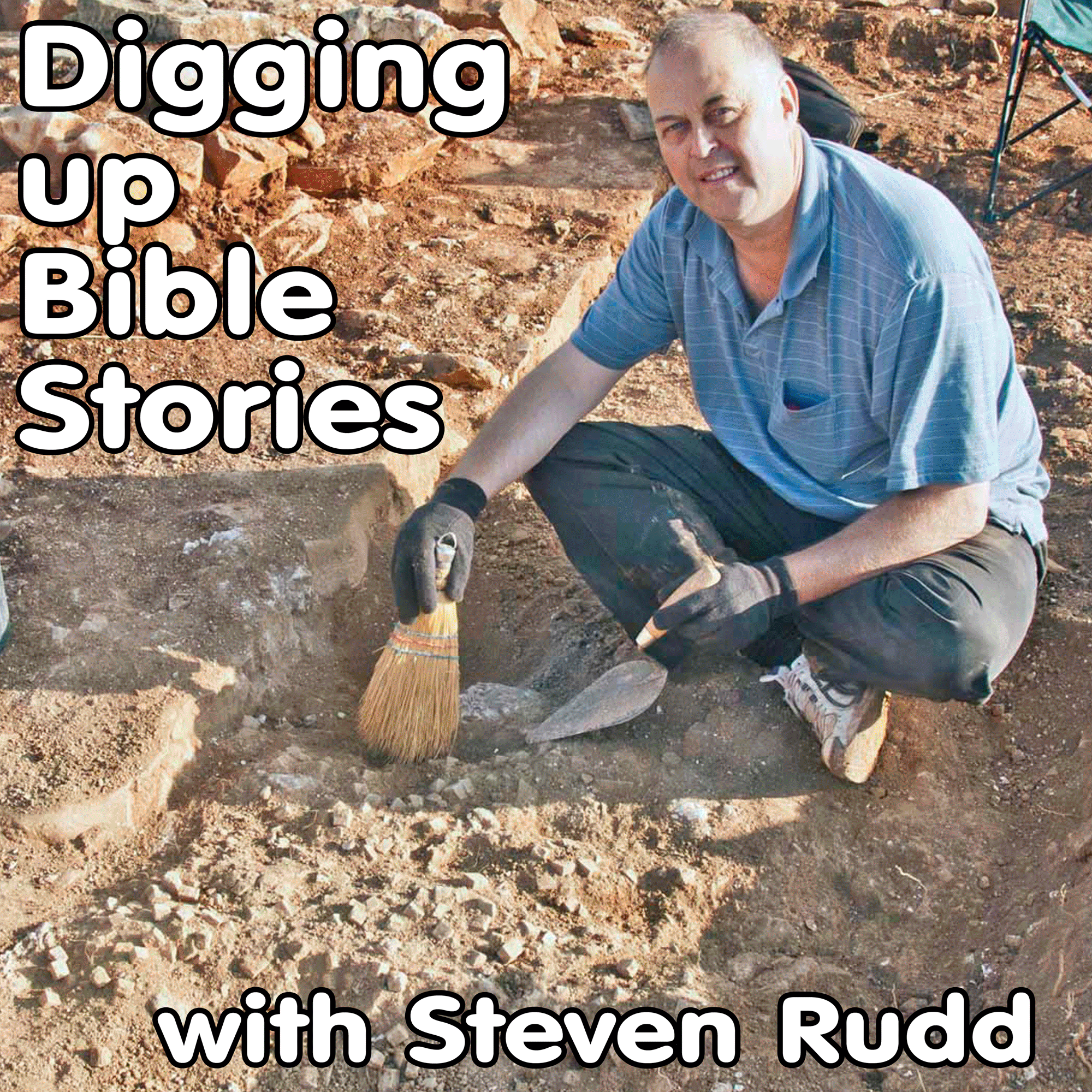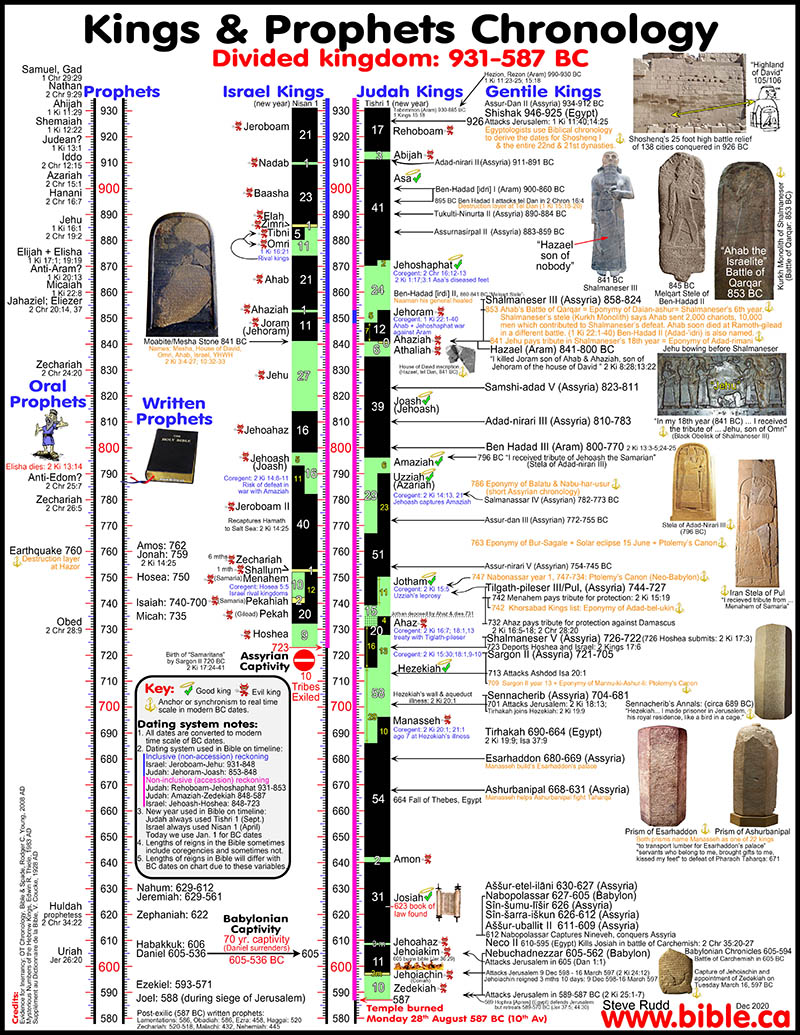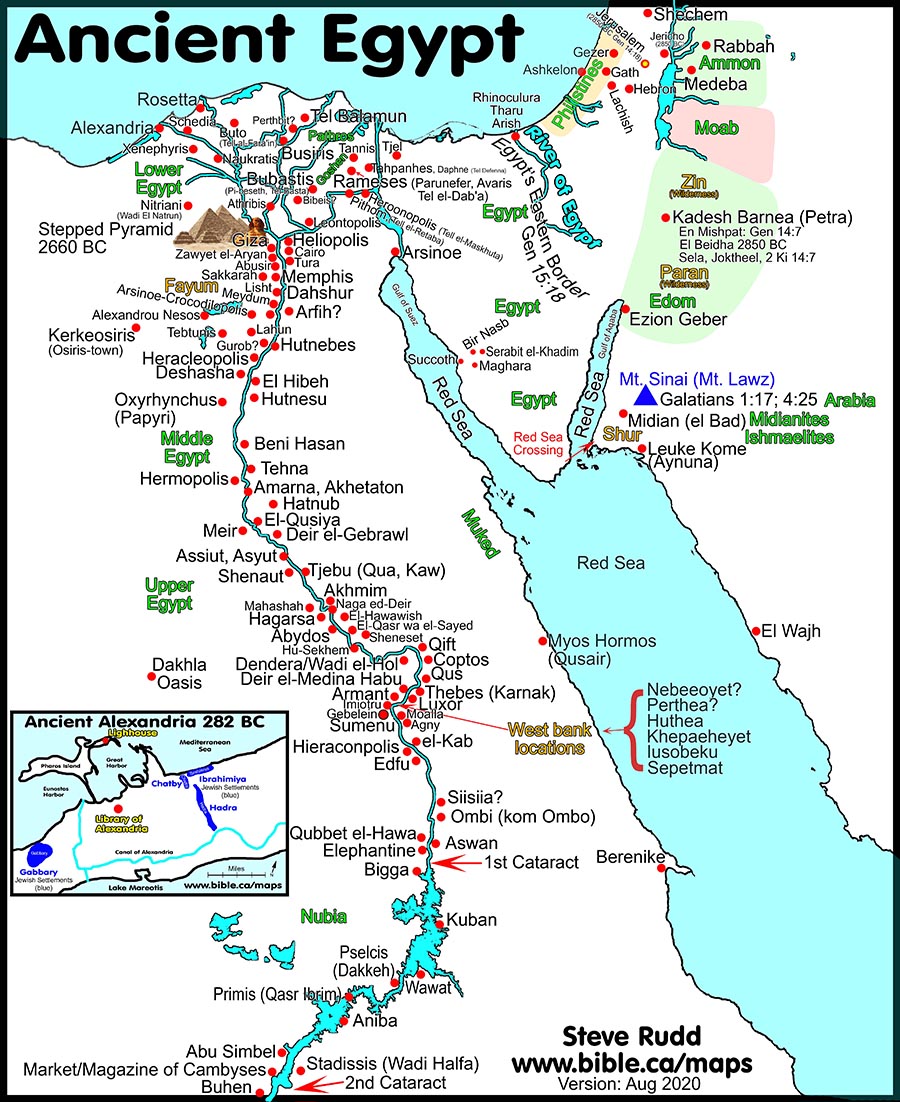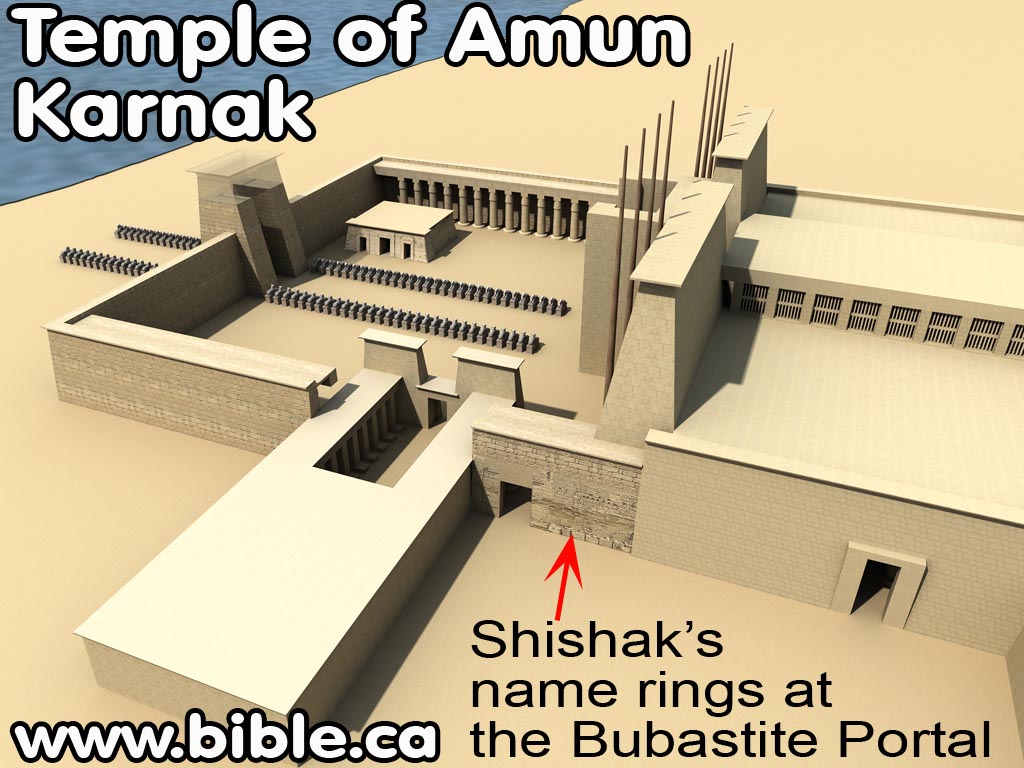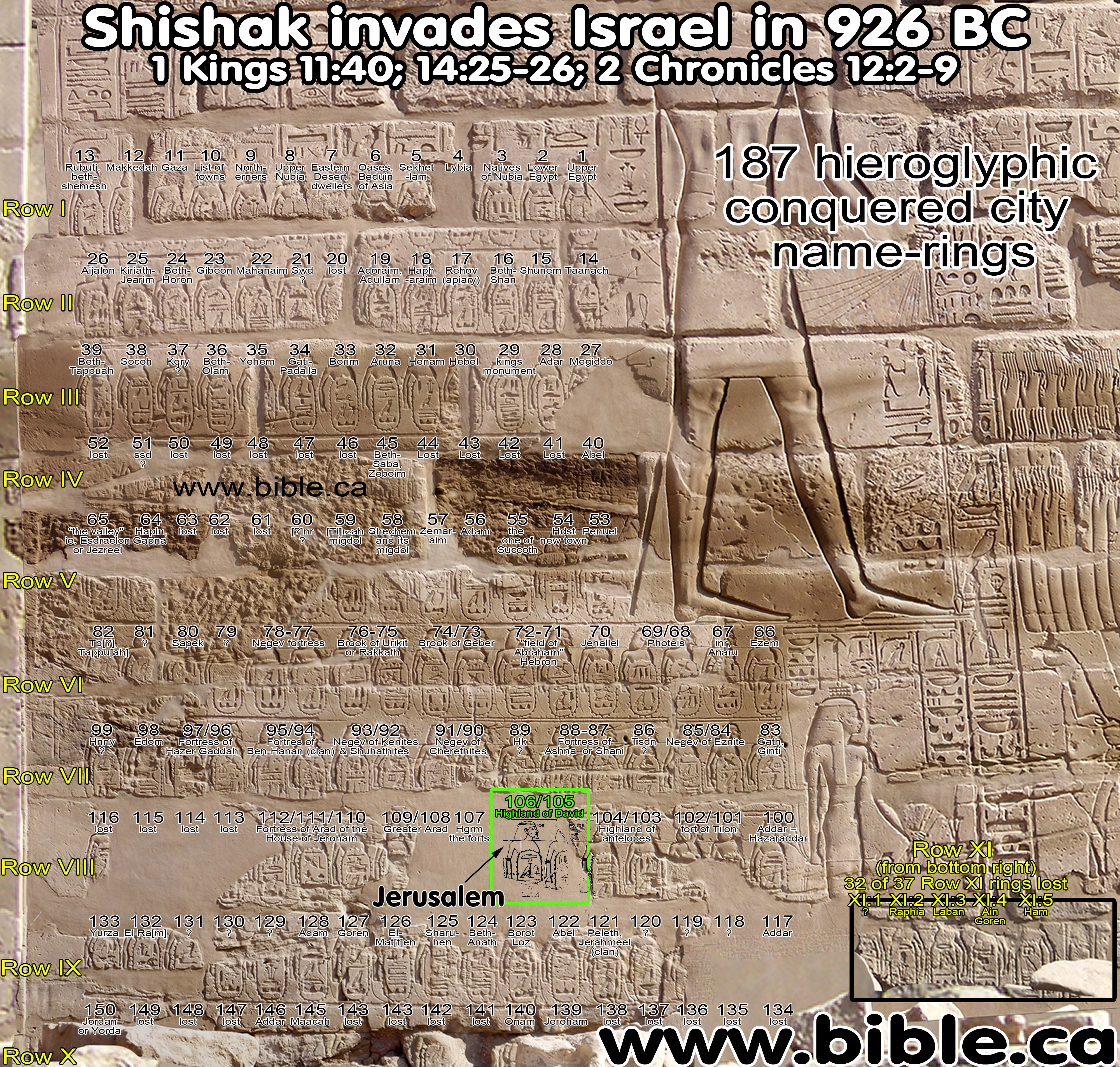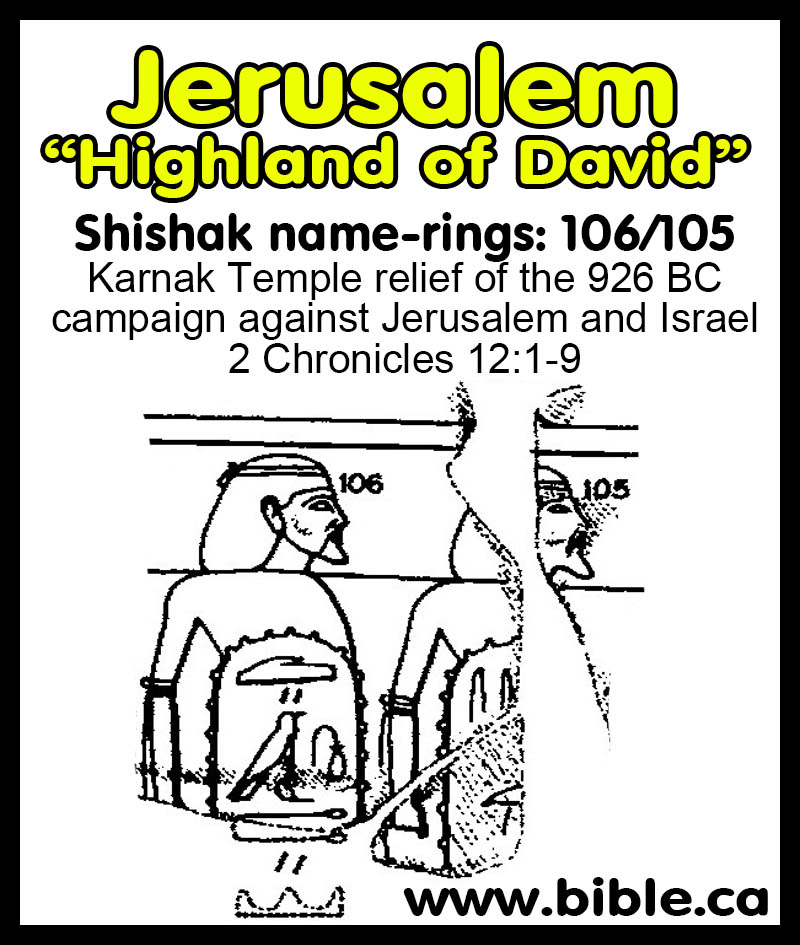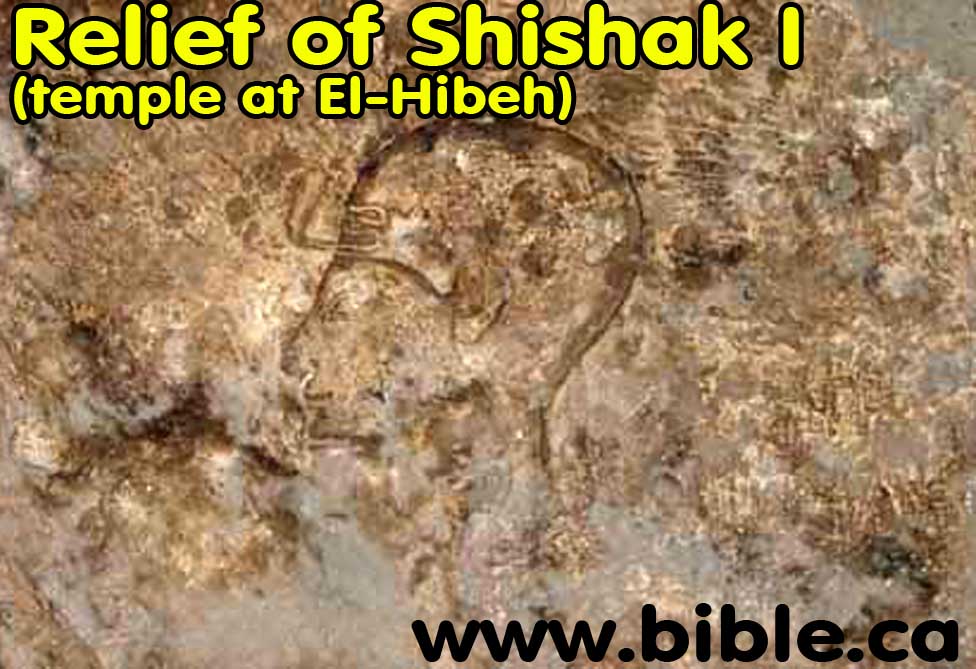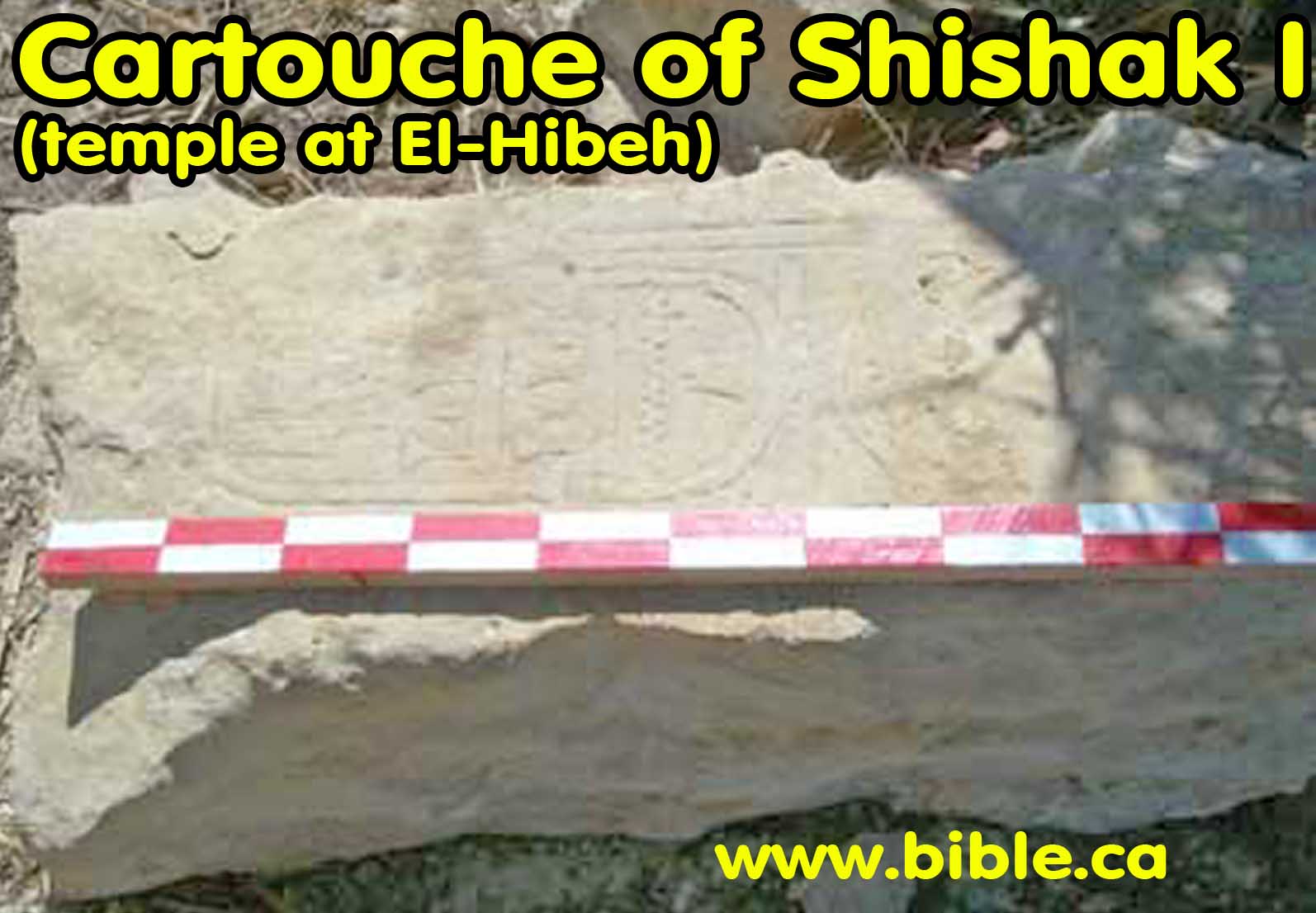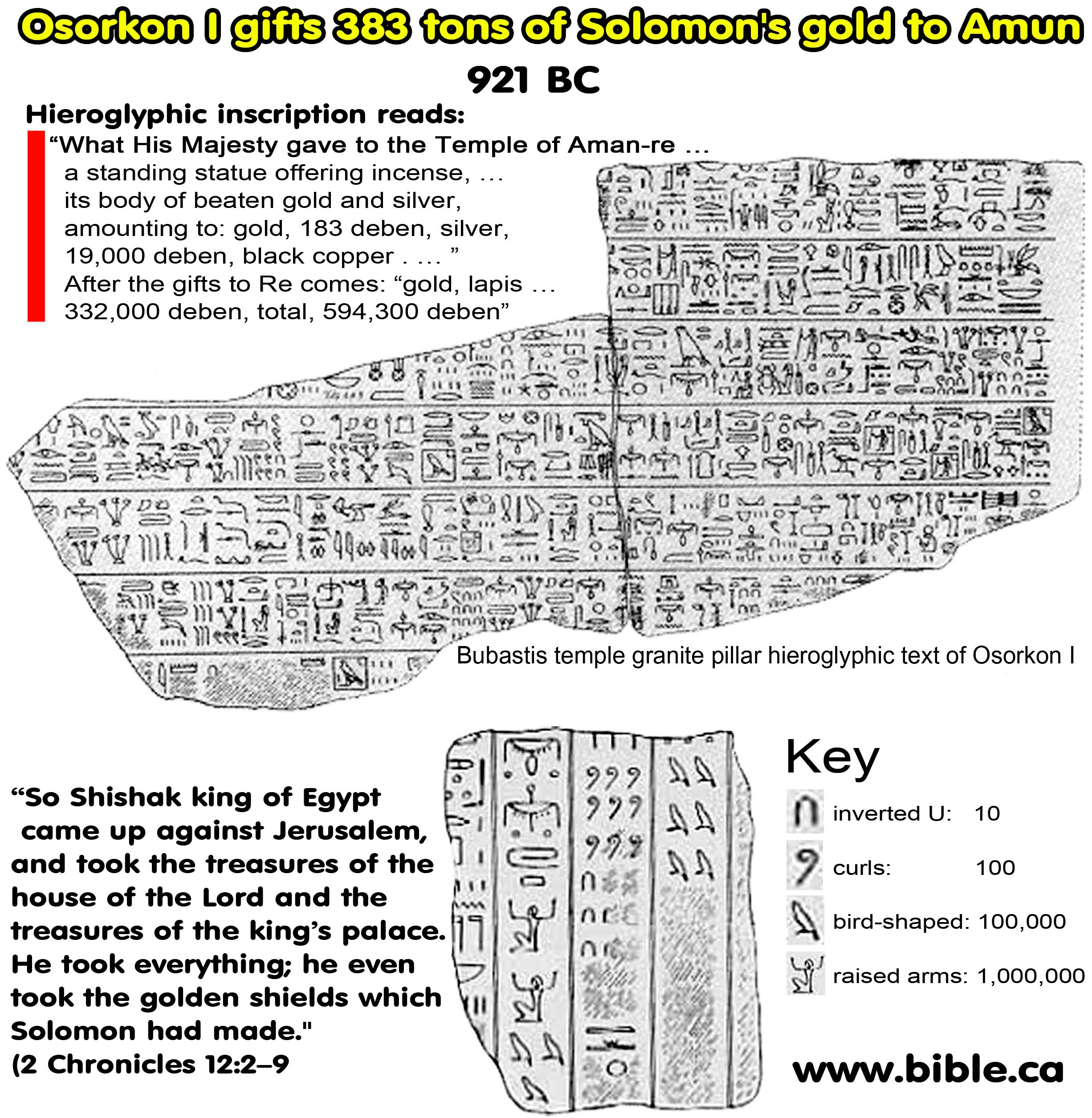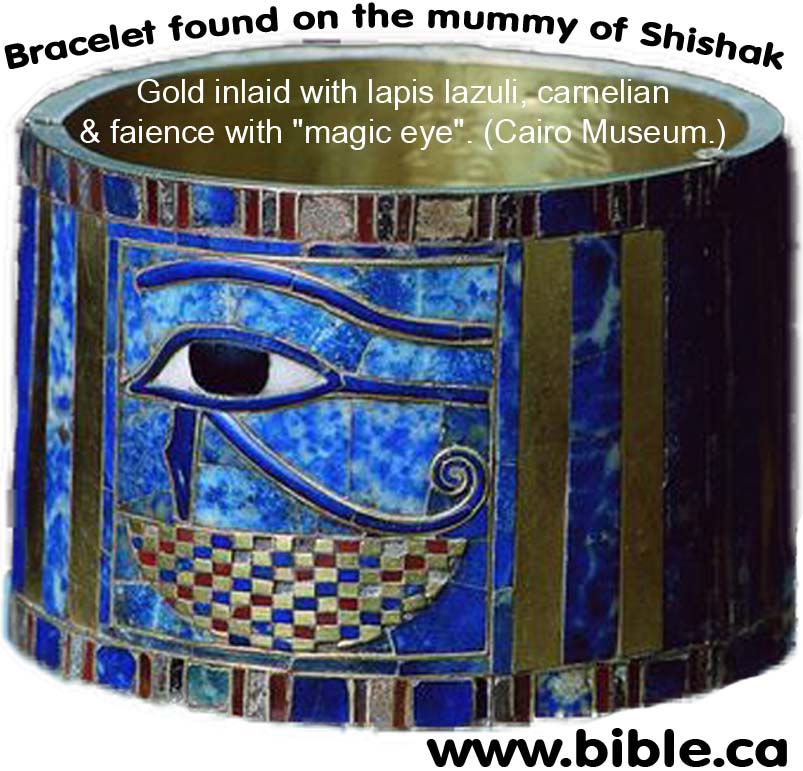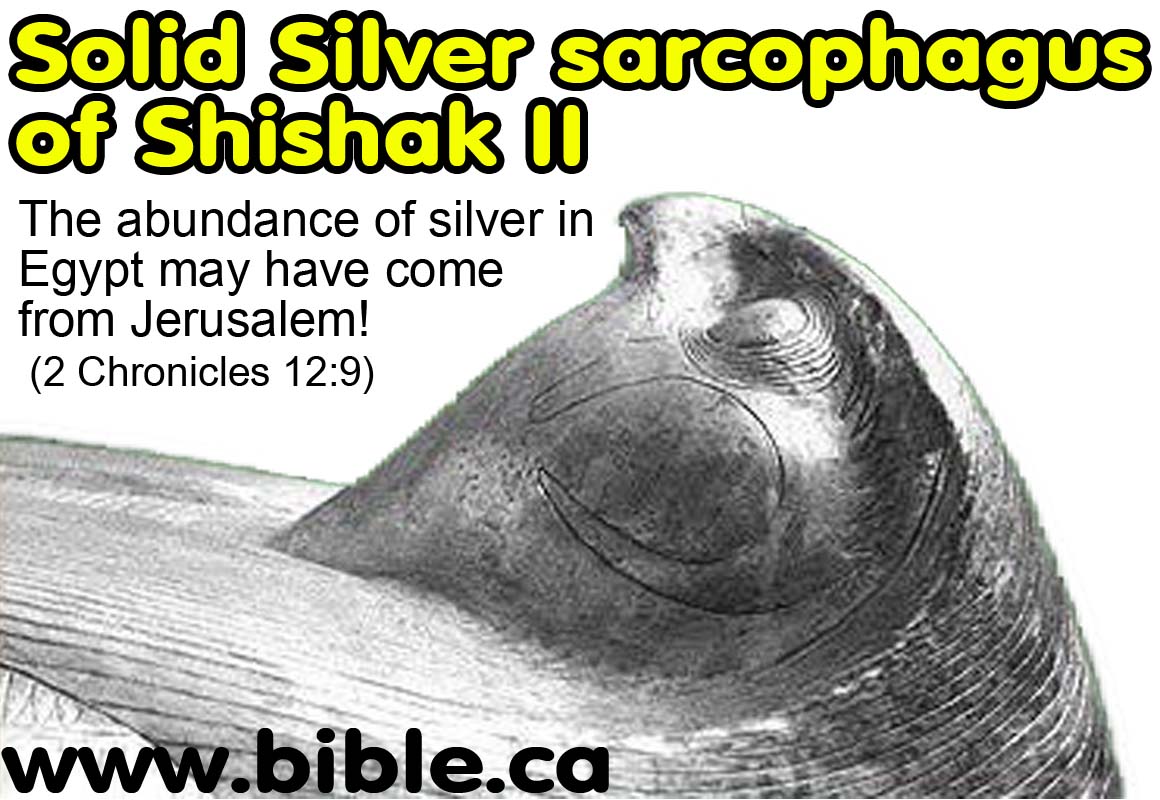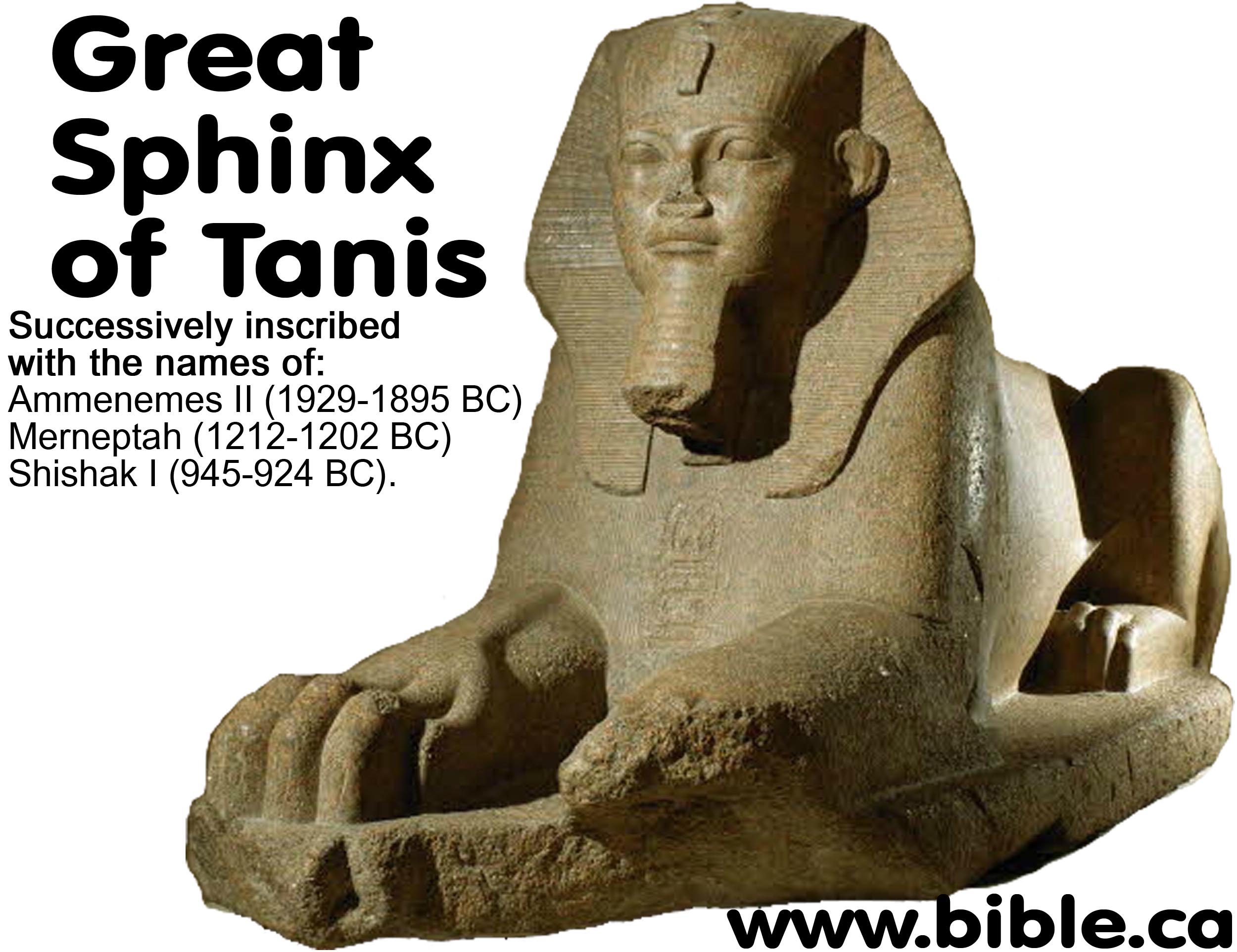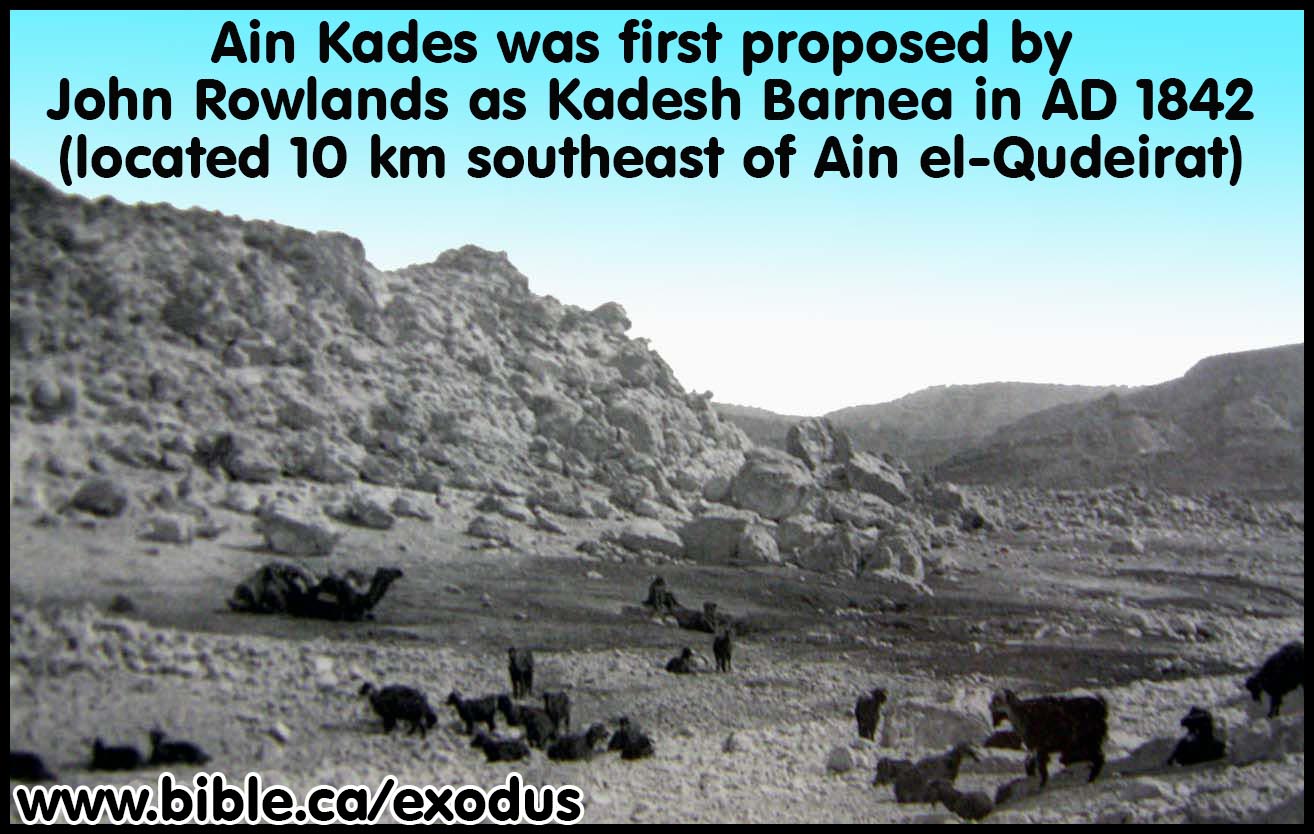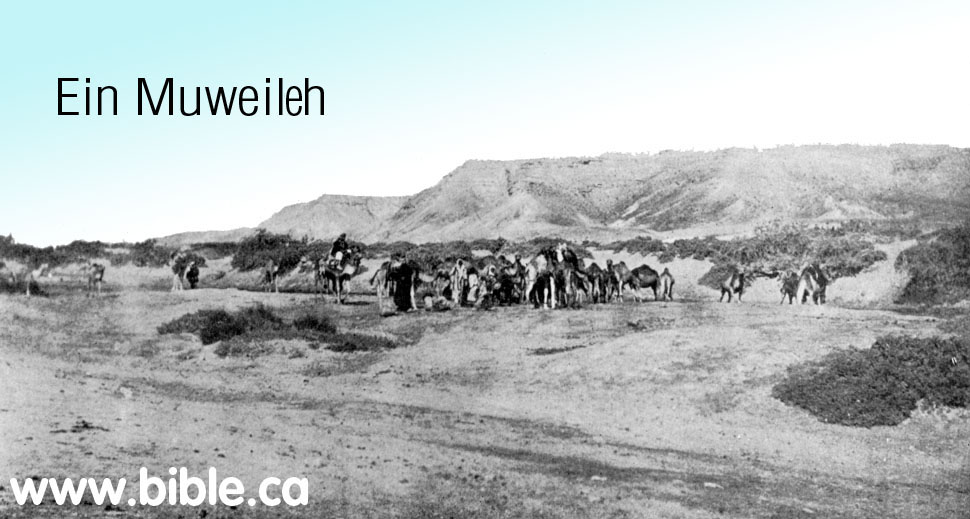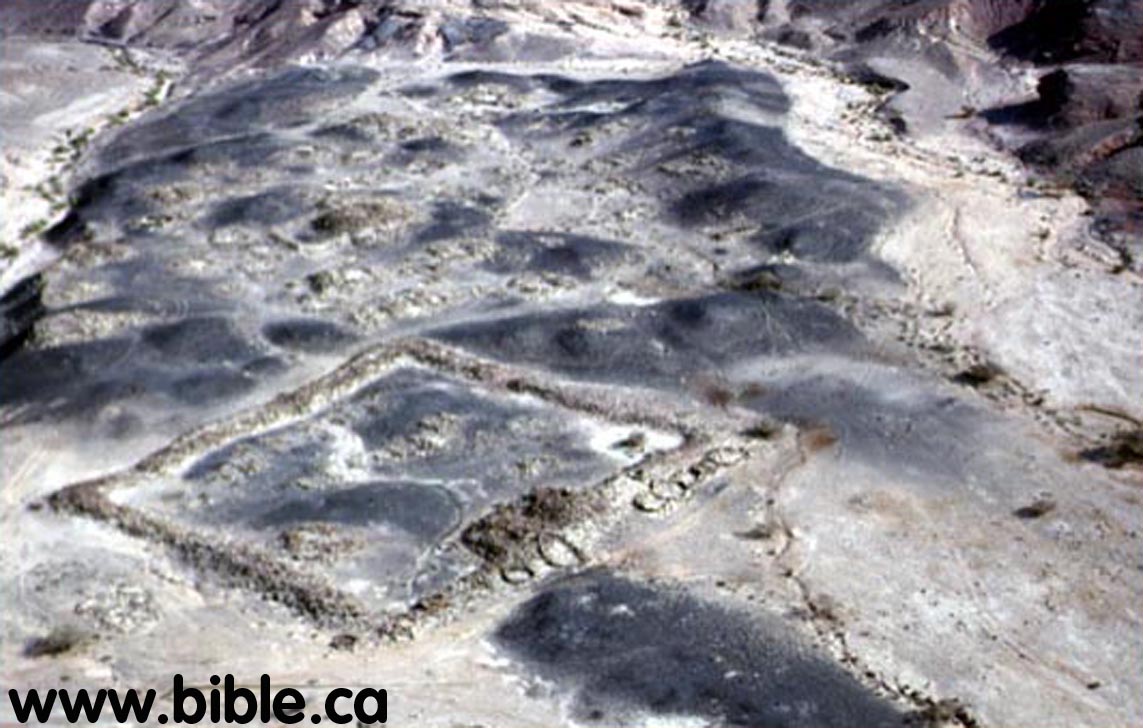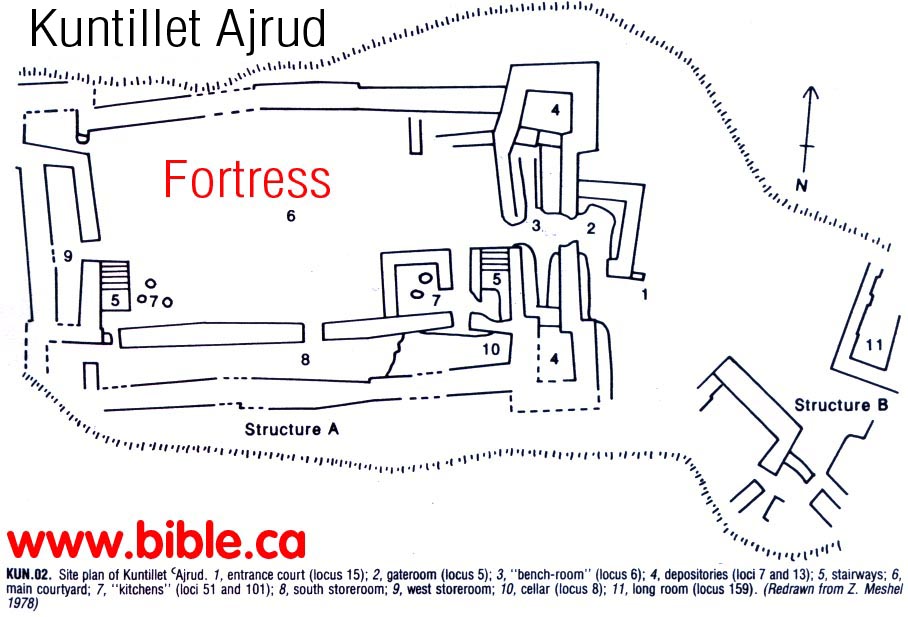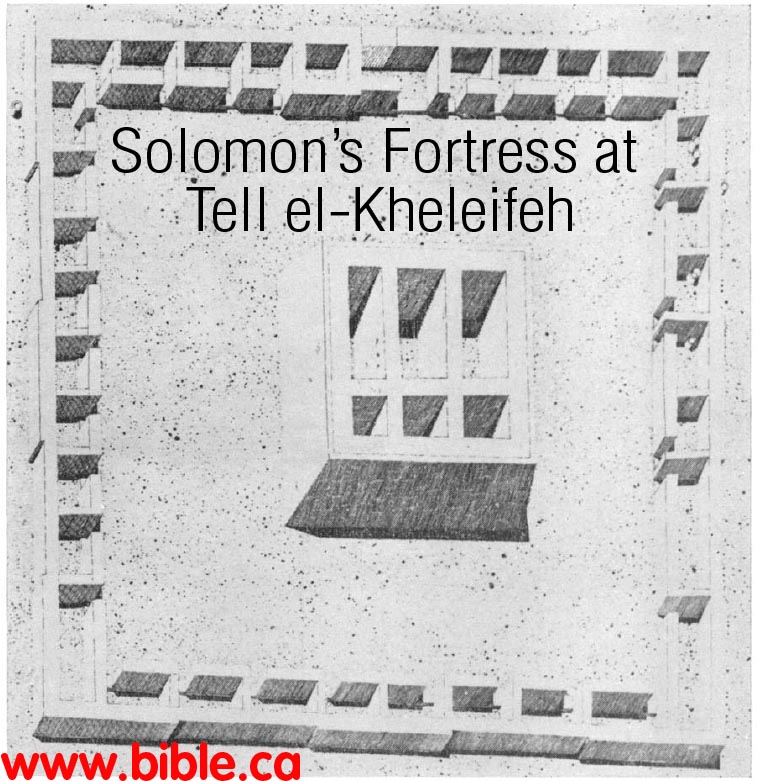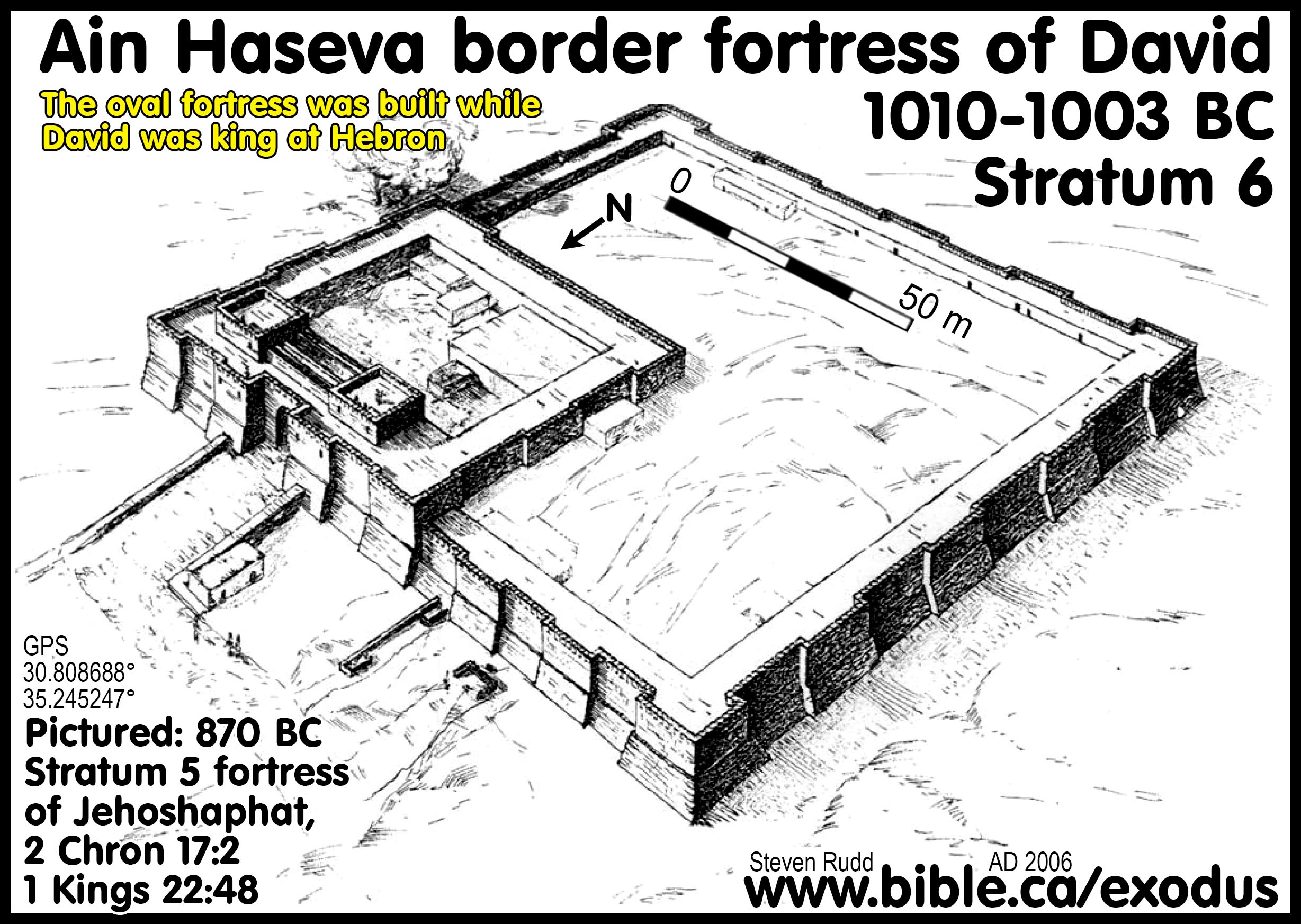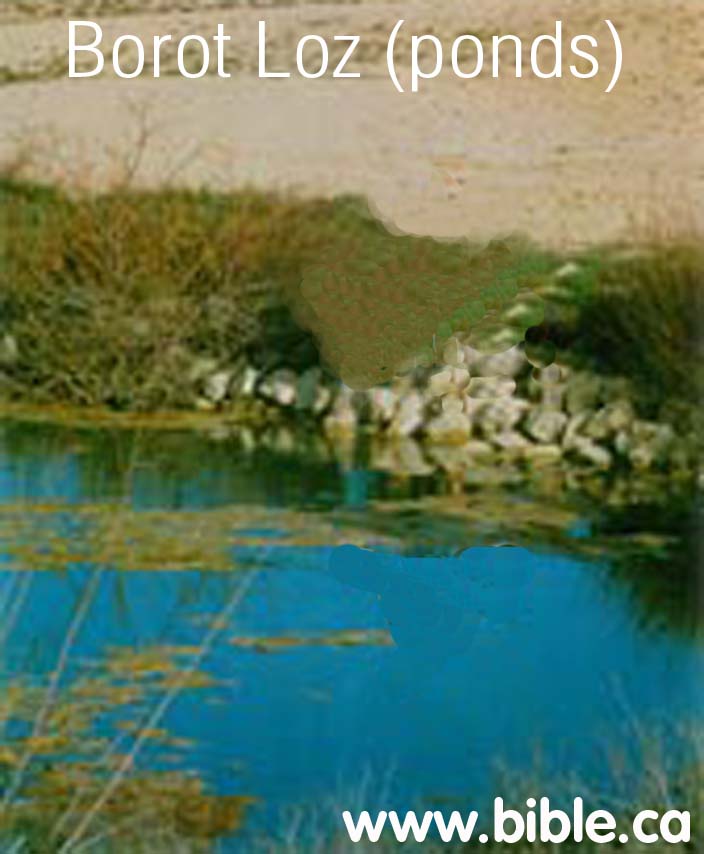Rehoboam, King of Judah (931-914 BC)
"Thus I (Solomon) hated all the fruit of my labor for
which I had labored under the sun,
for I must leave it to the man who will come after me.
And who knows whether he will be a wise man or a fool?
Yet he will have control over all the fruit of my labor for which I have
labored by acting wisely under the sun.
This too is vanity.
Therefore I completely despaired of all the fruit of my labor for which I had
labored under the sun."
(Ecclesiastes 2:18–20)
|
Shishak I, King of Egypt (945-924 BC) Karnak Invasion of Canaan relief: 926 BC 1 Kings 11:40; 14:25-26; 2 Chronicles 12:2-9 187 city "name rings" in Israel and 43 Bible cities! |
|
|
|
|
|
Shishak Battle Relief at Karnak: Photos and drawings with labeled name rings: Each town is represented by one, two or three name rings that appear as Hebrew captive slaves with their hands tied behind their backs and their necks tied together in a string of ropes. Note the hairstyle and beard which represents that the Jews looked like in 926 BC. Central to the relief is the Egyptian pagan god Amon-Ra with the tall double crown. Pharaoh Shishak is seen in all his conquering glory to the right in a large body outline that is still visible. In the center bottom are all the conquered Hebrew city mayors (chieftains) with uplifted hands as a sign of submission to Shishak to whom they paid tribute. Rehoboam fortified 15 cities, four of which were conquered by Shishak and have a corresponding name ring: Gath, Hebron, Adoraim, Aijalon. Click on images for high resolution |
|
|
|
||||
|
43 Bible cities listed in 926 BC Pictured here are three of the 187 city name rings on the wall of the Temple of Amun in Karnak, Egypt from the Shishak invasion of Israel and Judah in 926 BC just as the Bible says! There are at least 43 name rings that are known Bible cities! |
||||
|
Archaeologists are digging up bible stories!!! |
||||
|
Archaeology is an important science that confirms the historical accuracy of the Bible. Since the Bible refers to hundreds of cities, kings, and places, we would expect to find evidence from on-site excavations. And this is exactly what we have found. The Bible is the most historically accurate book of history on earth. Read the Bible daily! |
|
|||
Rehoboam, King of Judah (931-914 BC)
"Thus I
(Solomon) hated all the fruit of my labor for which I had labored under the
sun,
for I must leave it to the man who will come after me.
And who knows whether he will be a wise man or a fool?
Yet he will have control over all the fruit of my labor for which I have
labored by acting wisely under the sun.
This too is vanity.
Therefore I completely despaired of all the fruit of my labor for which I had
labored under the sun."
(Ecclesiastes 2:18–20)
Shishak I, King of Egypt (945-924 BC)
Karnak Invasion of Canaan relief: 926 BC
1 Kings 11:40; 14:25-26; 2 Chronicles 12:2-9
187 city "name rings" in Israel and 43 Bible cities!
Introduction:
- Rehoboam (931-914 BC) was Solomon's son who succeeded him on the throne of Judah and goes down in history as the "foolish son king" whose lack of wisdom divided the kingdom in two.
- Rehoboam was 41 years old when he became king, not a teenager!
- For the first three years, Rehoboam was a good king, but then he went bad.
- God sent Shishak, king of Egypt in 926 BC (year 5 of Rehoboam's rule) to conquer Judah because of the rampant idolatry.
- Shishak's invasion is recorded in a huge relief in Karnak Egypt as a parallel witness to the Bible account.
- In Karnak, Egypt is the Temple of Amun with the Victory relief of Shishak I (945-924 BC).
- Discovered in 1799 AD, the famous Shishak I relief of is conquest of Israel in 926 BC is located in the Bubastite Portal at the south entrance to the great First Court of this temple of Amun. See map for location of Karnak.
- "Shoshenq I (ca. 945-924 b.c.), the biblical Shishak, was a man of Libyan ancestry who founded the twenty-second dynasty and ruled Egypt from a city called Bubastis in the eastern Delta. As we have seen, he gave Jeroboam asylum after his first, abortive revolt against Solomon (11:40), evidently as part of a policy of neutralizing the power of Jerusalem in Palestine. It is tempting, therefore, to interpret his invasion as continuing support for Jeroboam in his struggle against Judah. The biblical accounts give the impression that the raid was directed only at Jerusalem (v. 25) or the fortified cities of Judah and Jerusalem (2 Chron. 12:4), and Rehoboam seems to have had to strip both the Temple and the palace for tribute to save the city (1 Kings 14:26; for Solomon’s gold shields, see commentary above on 10:14-29). The editorial insertion of the present account immediately following a denunciation of Rehoboam’s religious policies (14:22-24) implies that the attack was divine punishment for the religious inconstancy of Rehoboam, and the leaders of Judah, and this is made explicit in the parallel account in 2 Chron. 12:5. But the city list Shishak left at Karnak names cities captured as far east as Penuel in Transjordan, which had been fortified by Jeroboam (cf. 1 Kings 12:25), and as far north as Megiddo, where a fragment of a Shishak stele has been found. Thus we must conclude that Jeroboam, once his own kingship was established, lost favor with Shishak and that the invasion was an attempt to reassert Egypt’s ancient control over Palestine as a whole." (Shishak's Invation, Harper’s Bible commentary, J. L. Mays, p316, 1988 AD)
- When Solomon learned that the prophet Ahijah had anointed Jeroboam as king of ten tribes, he tried to kill him, which triggered him to flee to Shishak for sanctuary. We now know from the Relief that Shishak tried to dispose Jeroboam, (or make him a vessel king) since Tizrah, the capital city of Jeroboam, was one of the name rings of conquered cities!
- "Then Jeroboam the son of Nebat, an Ephraimite of Zeredah, Solomon’s servant, whose mother’s name was Zeruah, a widow, also rebelled against the king. Now this was the reason why he rebelled against the king: Solomon built the Millo, and closed up the breach of the city of his father David. Now the man Jeroboam was a valiant warrior, and when Solomon saw that the young man was industrious, he appointed him over all the forced labor of the house of Joseph. It came about at that time, when Jeroboam went out of Jerusalem, that the prophet Ahijah the Shilonite found him on the road. Now Ahijah had clothed himself with a new cloak; and both of them were alone in the field. Then Ahijah took hold of the new cloak which was on him and tore it into twelve pieces. He said to Jeroboam, “Take for yourself ten pieces; for thus says the Lord, the God of Israel, ‘Behold, I will tear the kingdom out of the hand of Solomon and give you ten tribes (but he will have one tribe, for the sake of My servant David and for the sake of Jerusalem, the city which I have chosen from all the tribes of Israel), because they have forsaken Me, and have worshiped Ashtoreth the goddess of the Sidonians, Chemosh the god of Moab, and Milcom the god of the sons of Ammon; and they have not walked in My ways, doing what is right in My sight and observing My statutes and My ordinances, as his father David did. ‘Nevertheless I will not take the whole kingdom out of his hand, but I will make him ruler all the days of his life, for the sake of My servant David whom I chose, who observed My commandments and My statutes; but I will take the kingdom from his son’s hand and give it to you, even ten tribes. ‘But to his son I will give one tribe, that My servant David may have a lamp always before Me in Jerusalem, the city where I have chosen for Myself to put My name. ‘I will take you, and you shall reign over whatever you desire, and you shall be king over Israel. ‘Then it will be, that if you listen to all that I command you and walk in My ways, and do what is right in My sight by observing My statutes and My commandments, as My servant David did, then I will be with you and build you an enduring house as I built for David, and I will give Israel to you. ‘Thus I will afflict the descendants of David for this, but not always.’ ” Solomon sought therefore to put Jeroboam to death; but Jeroboam arose and fled to Egypt to Shishak king of Egypt, and he was in Egypt until the death of Solomon." (1 Kings 11:26–40)
- The Bible allows us to set Shishak I into his time slot and dates the invasion to the 5th year of King Rehoboam in 926 BC.
- "Now it happened in the fifth year of King Rehoboam, that Shishak the king of Egypt came up against Jerusalem. He took away the treasures of the house of the Lord and the treasures of the king’s house, and he took everything, even taking all the shields of gold which Solomon had made." (1 Kings 14:25-26)
- "And it came about in King Rehoboam’s fifth year, because they had been unfaithful to the Lord, that Shishak king of Egypt came up against Jerusalem with 1,200 chariots and 60,000 horsemen. And the people who came with him from Egypt were without number: the Lubim, the Sukkiim and the Ethiopians. He captured the fortified cities of Judah and came as far as Jerusalem. Then Shemaiah the prophet came to Rehoboam and the princes of Judah who had gathered at Jerusalem because of Shishak, and he said to them, “Thus says the Lord, ‘You have forsaken Me, so I also have forsaken you to Shishak.’ ” So the princes of Israel and the king humbled themselves and said, “The Lord is righteous.” When the Lord saw that they humbled themselves, the word of the Lord came to Shemaiah, saying, “They have humbled themselves so I will not destroy them, but I will grant them some measure of deliverance, and My wrath shall not be poured out on Jerusalem by means of Shishak. “But they will become his slaves so that they may learn the difference between My service and the service of the kingdoms of the countries.” So Shishak king of Egypt came up against Jerusalem, and took the treasures of the house of the Lord and the treasures of the king’s palace. He took everything; he even took the golden shields which Solomon had made." (2 Chronicles 12:2-9)
- Variations of the Bible spelling of Shishak I include:
a. Sheshonq I
b. Shoshenq I
c. Shishaq I
d. Susac I
e. Shoshenk I
6. The 7.6 meter high relief contains about 187 different "name rings", each representing a city or place conquered by Shishak in his 926 BC invasion of Israel and Canaan.
a. Only about 125 are visible today. Some have been destroyed, vandalized or looted since the time they were documented. Others were lost long earlier.
b. There are 11 rows of name-rings that make up the 187 city names.
7. "GENERAL DESCRIPTION OF THE BUBAS'TITE PORTAL: The Bubastite Portal is the south entrance to the great First Court of the Temple of Amun at Karnak. It was architecturally conceived as a uniform part of the wall and colonnade surrounding the court. Had it not been for the presence of the temple of Ramses III in the way, this entrance would probably have been placed directly opposite the north entrance at a point almost exactly in the middle of the Ramses temple. Under the circumstances it was built to occupy the space between the Second Pylon and the Ramses temple, and became somewhat more elaborate than the north entrance by the necessary addition of a pilaster against each of the earlier structures. Both north and south walls of the court exactly continue the corresponding walls of the Hypostyle Hall. This was made simple by the fact that the walls of the Hypostyle Hall had been built so as to overlap partially the ends of the Second Pylon because the hall assumed greater proportions than could be inclosed by walls abutting as was customary on the back of the pylon. The walls of the First Court thus continue from the ends of the walls of the Hypostyle Hall overlapping the remainder of the ends of the Second Pylon. Of the area occupied by the thickness of the Bubastite Portal on the face of the Second Pylon only the portion on which the east pilaster abuts is obscured by masonry. On the contrary, the entire area of the east wall of the Ramses III temple from the facade of the portal to the north edge of the west pilaster is covered with the masonry of the portal. There is one fact of importance which must be kept in mind in any consideration of the Bubastite Portal and of the court of which it is a part. Although the portal is an integral part in design of the wall and colonnade inclosing the court, it is physically a separate entity. In the building process it could have been and undoubtedly was erected as a unit and most likely first. The mud-brick scaffolds and ramps used in erecting it could have been built and then removed without reference to those required for constructing the remainder of the enclosure. So also the dressing of the surfaces and the decoration could be done and obviously- were done without reference to the rest of the wall and colonnade." (Reliefs and Inscriptions at Karnak: The Bubasite Portal by The Epigraphic Survey, George R. Hughes, The University Of Chicago Oriental Institute Publications Volume LXXIV, 1954 AD)
8. "A more extensive description of the campaign was inscribed by Shishak himself on the walls of the Temple of Amon in Karnak. In this victory inscription, which is one of the most important historical documents of its time, Shishak lists the names of the cities, villages and settlements he conquered. The first part of the inscription contains a long list of sites in the northern and central sections of Israel. The second part of the inscription, containing over 10 names, is apparently devoted to the Negev. Only a few of the names can be identified with cities known from the Bible. These include Arad, Yurza, Sharnhen, and the proposed identification of Ezion-Geber, which is doubtful. Of particular interest to us here are nine place-names formed with the component p.h\-q-r, which can be readily associated with the Semitic root h\-g-r ("fort"). The list includes, for example, the fortress of Great Arad, which clearly refers to the site still bearing that name. Identifying the other fortresses referred to by Shishak is more problematic, but it may well be that a number of the names refer to the fortresses we have been discussing." (The Fortresses King Solomon Built to Protect His Southern Border, Rudolph Cohen, 1985 AD)
I. Rehoboam (931-914 BC), The Foolish King:
|
1. Very few kings were as stupid and foolish in dealing with his people as Rehoboam. He chose to listen to the advice of his young drinking buddies rather than the advice of his parents best friends! 2. God chose and anointed Jeroboam as King to replace Solomon even before Rehoboam became king! 3. “Then Ahijah took hold of the new cloak which was on him and tore it into twelve pieces. He said to Jeroboam, “Take for yourself ten pieces; for thus says the Lord, the God of Israel, ‘Behold, I will tear the kingdom out of the hand of Solomon and give you ten tribes (but he will have one tribe, for the sake of My servant David and for the sake of Jerusalem, the city which I have chosen from all the tribes of Israel), because they have forsaken Me, and have worshiped Ashtoreth the goddess of the Sidonians, Chemosh the god of Moab, and Milcom the god of the sons of Ammon; and they have not walked in My ways, doing what is right in My sight and observing My statutes and My ordinances, as his father David did.” (1 Kings 11:30–33) |
- When Solomon learned that Jeroboam would divide the kingdom and get 10 tribes, Jeroboam fled to Egypt and was "called out of Egypt" home to Shechem.
a. There is some kind of meaning to God calling his anointed or chosen out of Egypt. Clearly the prophecy of Hosea being applied to Jesus in Mt 2:14-15 is noteworthy. Perhaps only after the second coming will we learn historical details before the world was created as to why this is important. Perhaps the angels understand the antitypical importance.
- Abraham fled to Egypt and returned to Ai to be given the promised land.
- Israel was called out of Egypt during the exodus: “When Israel was a youth I loved him, And out of Egypt I called My son.” (Hosea 11:1)
- Jeroboam was called out of Egypt by the ten tribes to be king.
- Jesus was called out of Egypt: “So Joseph got up and took the Child and His mother while it was still night, and left for Egypt. He remained there until the death of Herod. This was to fulfill what had been spoken by the Lord through the prophet: “Out of Egypt I called My Son.”” (Matthew 2:14–15)
- When Solomon died, all 12 tribes gathered at Shechem to make Rehoboam, son of Solomon, king.
a. Jeroboam was recalled from Egypt and present in the assembly.
b. Rehoboam rejected the wise advice of his father's elders and accepting the advice of his young foolish drinking buddies: "The young men who grew up with him spoke to him, saying, “Thus you shall say to this people who spoke to you, saying, ‘Your father made our yoke heavy, now you make it lighter for us!’ But you shall speak to them, ‘My little finger is thicker than my father’s loins!” (1 Kings 12:10)
c. My little finger is thicker than my father’s loins: Really? Are you kidding? It sounds like something a 15-year-old teenager would say, not a 41-year-old king.
d. In fact Rehoboam was 41 years old when he became king: “Rehoboam was forty-one years old when he became king, and he reigned seventeen years in Jerusalem.” (1 Kings 14:21)
i. For a 41 year old man, he must have been a listless, mindless, immature jellyfish.
ii. “worthless men gathered about Jeroboam, scoundrels, who proved too strong for Rehoboam, the son of Solomon, when he was young and timid and could not hold his own against them.” (2 Chronicles 13:6–7)
iii. This brought about the God-ordained division of the kingdom into two.
- Rehoboam sent a commander Adoram, who replaced Jeroboam after he fled to Egypt and Israel stoned him: “Then King Rehoboam sent Adoram, who was over the forced labor, and all Israel stoned him to death. And King Rehoboam made haste to mount his chariot to flee to Jerusalem.” (1 Kings 12:18)
a. Rehoboam gathered his army to attack Jeroboam, but Shemaiah the prophet to call off the attack: 1 Kings 12:21
b. "Now when Rehoboam had come to Jerusalem, he assembled all the house of Judah and the tribe of Benjamin, 180,000 chosen men who were warriors, to fight against the house of Israel to restore the kingdom to Rehoboam the son of Solomon. But the word of God came to Shemaiah the man of God, saying, “Speak to Rehoboam the son of Solomon, king of Judah, and to all the house of Judah and Benjamin and to the rest of the people, saying, ‘Thus says the Lord, “You must not go up and fight against your relatives the sons of Israel; return every man to his house, for this thing has come from Me.” ’ ” So they listened to the word of the Lord, and returned and went their way according to the word of the Lord." (1 Kings 12:21–24)
- The division of the kingdom was now complete, stable and not to be truly united again until the time of Christ.
- Rehoboam fortified 15 cities in Judah in order to protect against Jeroboam: Bethlehem, Etam, Tekoa, Beth-zur, Soco, Adullam, Gath, Mareshah, Ziph, Adoraim, Lachish, Azekah, Zorah, Aijalon and Hebron.
a. "Rehoboam lived in Jerusalem and built cities for defense in Judah. Thus he built Bethlehem, Etam, Tekoa, Beth-zur, Soco, Adullam, Gath, Mareshah, Ziph, Adoraim, Lachish, Azekah, Zorah, Aijalon and Hebron, which are fortified cities in Judah and in Benjamin. He also strengthened the fortresses and put officers in them and stores of food, oil and wine. He put shields and spears in every city and strengthened them greatly. So he held Judah and Benjamin. Moreover, the priests and the Levites who were in all Israel stood with him from all their districts." (2 Chronicles 11:5–13)
b. At the end of year three, Rehoboam was doing good and the priests and levites were with him. However he turned bad and this triggered the anger of God so that Shishak invaded from Egypt
- In 926 BC, in the 5th year of Rehoboam, Shishak king of Egypt attacked and even captured four of the cities that Rehoboam had fortified: Gath, Aijalon, Adoram, Hebron.
- TEXT OF 1 Kings 12:24:a-z: as it is known in the Septuagint, is a huge gloss/addition in it that the Masoretic text of most Bibles. This translation is from "The Lexham English Septuagint., Brannan, R., Penner, K. M., Loken, I., Aubrey, M., & Hoogendyk, 1 Kings 12:24:a-z, 2012 AD".
a. 24a And King Solomon slept with his fathers, and he was buried with his fathers in the city of David. And Rehoboam his son reigned in place of him in Jerusalem, being sixteen years old when he began to reign, and twelve years he reigned in Jerusalem, and the name of his mother was Naanan the daughter of Hanan the son of Nahash king of Ammon. And he did what was evil before the Lord, and he did not go in the way of David his father.
b. 24b And there was a man from the mountain of Ephraim, a servant of Solomon, and his name was Jeroboam, and the name of his mother was Sarisa, a prostitute. And Solomon made him into chief of staff over the forced labor of the house to Joseph, and he built for Solomon Sarira, which is in the mountain of Ephraim, and there were to him three hundred horse-drawn chariots. This one built the citadel with the forced labor of the house of Ephraim, this one closed off the city of David, and he was exalted over the kingdom.
c. 24c And Solomon was trying to put him to death, and he was afraid and he fled to Shishak king of Egypt, and he was with him until Solomon died.
d. 24d And Jeroboam heard in Egypt that Solomon was dead. And he spoke into the ears of Shishak king of Egypt, saying, “Send me away, and I will depart to my land.” And Shishak said to him, “Ask any request, and I will give it to you.”
e. 24e And Shishak gave Jeroboam Ano the elder sister of Tahpenes his own wife to him for a wife. This one is great in the midst of the daughters of the king. And she bore for Jeroboam Abijah his son.
f. 24f And Jeroboam said to Shishak, “Send me out truly, and I will depart.” And Jeroboam came out from Egypt, and he came to the land of Sarira, which was in the mountain of Ephraim, and all the staffs of Ephraim were gathered together there, and Jeroboam built bulwarks there.
g. 24g And his child became sick ⌊with an exceedingly bad sickness⌋, and Jeroboam went to inquire concerning the child, and he said to Ano his wife, “Arise, go inquire of God concerning the child if he will live from his sickness.”
h. 24h And there was a man in Shiloh, and the name to him was Ahijah, and this one was sixty years old, and the word of the Lord was with him. And Jeroboam said to his wife, “Arise, and take into your hand for the man of God bread and cake for his children and grapes and a pot of honey.”
i. 24i And the woman arose and took into her hand bread and two cakes and grapes and a pot of honey to Ahijah. And the man was old, and his eyes became dim-sighted for seeing.
j. 24k And she arose from Sarira and she went, and it happened as she was coming into the city to Ahijah the Selonite, and Ahijah said to his servant, “Go out indeed for a meeting with Ano the wife of Jeroboam, and you shall say to her, ‘Enter and do not stand in position because the Lord says this, “I send harsh things upon you.” ’ ”
k. 24l And Ano entered to the man of God with cakes and a pot of honey. The Lord says this, “Behold, you will depart from me, and it will be when you entered the gate into Sarira and your maidservants will come out to you for a meeting, and they will say to you, ‘The child is dead.’
l. 24m Because the Lord says this, ‘Behold, I will utterly destroy those who urinate towards the wall of a house who belong to Jeroboam, and it will be the ones who died in the city who belong to Jeroboam, the dogs will devour, and the one who died in the field the birds of the sky will devour. And he will strike the child.’ Alas, Lord, for a good word was found in him concerning the Lord.”
m. 24n And the woman went out when she heard, and it happened when she entered into Sarira, and the child died, and the cry went out to meet her. And Jeroboam went to Shechem, which was in the mountain of Ephraim, and he gathered together there the tribes of Israel, and Rehoboam son of Solomon went up from there.
n. 24o And the word of the Lord came to Shemaiah the Elamite, saying, “Take for yourself a new garment that has not entered into water and tear it into twelve pieces, and you will give them to Jeroboam, and you shall say to him, ‘The Lord says this, “Take for yourself twelve pieces to throw round you.” ’ ” And Jeroboam took them, and Shemaiah said, “The Lord says this concerning the ten tribes of Israel.”
o. 24p And the people said to Rehoboam son of Solomon, “Your father made heavy his yoke upon us, and he made heavy the food of his table. And now you made it easier on us, we will serve you.” And Rehoboam said to the people, “There are still three days and I will reply a word to you.”
p. 24q And Rehoboam said, “Bring me the elders and I will take counsel with them, what word I answer the people on the third day.” And Rehoboam spoke into their ears just as the people sent to him, and the elders of the people said, “Thus the people spoke to you.”
q. 24r And Rehoboam rejected their counsel, and it was not pleasing before him, and he sent and brought in his comrades, and he spoke to them the same things, “And these things the people sent to me, saying.” And his comrades said, “Thus you will speak to the people, saying, ‘My smallness is thicker than the loins of my father; my father chastised you with whips, but I would rule you with scorpions.’ ”
r. 24s And the word was pleasing before Rehoboam, and he replied to the people just as his comrades the young men advised him. 24t And all the people spoke as one man each to his neighbor, and all were crying out, saying, “A portion is not for us in David, nor an inheritance in the son of Jesse. To your tents, Israel, because this man will not be a ruler nor a leader.”
s. 24u And all the people scattered from Shechem and went out each into his tent. And Rehoboam strengthened himself and went out and went up upon his chariot, and he entered into Jerusalem, and the whole tribe of Judah and the whole tribe of Benjamin went after him.
t. 24x And it happened when the year began, and Rehoboam gathered together every man of Judah and of Benjamin, and he went up to fight against Jeroboam in Shechem.
u. 24y And the word of the Lord came to Shemaiah the man of God, “Say to Rehoboam king of Judah and to all the house of Judah and of Benjamin and to the remnant of the people, saying, ‘The Lord says this, “You shall not go up nor fight against your brothers the children of Israel. Turn aside each of you to his house because this word came from me.” ’ ”
v. 24z And they heard the word of the Lord, and they ceased from going according to the word of the Lord.
- DISCUSSION OF 1 Kings 12:24:a-z:
a. The LXX text adds three new details lacking in the Masoretic manuscript: that Rehoboam "sixteen years old when he began to reign and he reigned for 12 years" (24a), the name of Jeroboam's mother was "Sarisa, a prostitute" (24b) and " Shishak gave Jeroboam Ano the elder sister of Tahpenes his own wife to him for a wife" (24e).
b. Other than this, the stories are essentially identical.
c. However, 1 Kings 14:21 plainly tells us that Rehoboam was 41 years old and he reigned 17 years , not 16 years old reigning 12 years. This is one good reason to reject it as spurious text in addition to all the other sensational statements about Jeroboam's mother being a prostitute!
d. "Scholarly study has focused on the evolution of this story, questioning whether it represents a recension of mt Kings—i.e., a purposeful reworking of the text (“midrashic” [Montgomery and Gehman, 254]; “strange and arbitrarily ordered compilation” [Noth, 270])—or an earlier (pre-Dtr) version of the Jeroboam story that preserves traditions rejected in the development of mt (“an independent Northern tradition … worked over by a Judean editor” [Gray, 311]?). However, Talshir’s exhaustive analysis (1990) has shown that the author of the addition fashioned the story out of ready-made components, freely adding and arranging them with great skill. He created a coherent retrospective that is critical of both the protagonist (Rehoboam) and the antagonist (Jeroboam). A few items in the addition suggest that at its base was the narration now preserved in mt. For example, the prophecy of doom tendered by Ahijah to the wife of Jeroboam concerning her sick child is suited more to a royal personage than to the child (v. 24m), yet according to the order of events in the story, Jeroboam has not yet become king. This item has been repositioned from its natural context attested to in mt (14:10–11). Or, if the Shemaiah episode (12:21–24) is a post-Dtr addition to Kings, as seems likely, the writer of the alternative story used it and its prophetic spokesman creatively in his new-spun tale. Talshir’s suggestion is that the story was written in translation Greek from a Hebrew Vorlage (that can be sensed, for one thing, by a number of wordplays stemming from similar-sounding words in the reconstructed Hebrew; e.g., 12:24f: mṣrym, ṣrrh, mṣwr). It is a “historical midrash,” not unlike what may be found in the work of the biblical Chronicler; yet because of its shortness, the date and home of the story are difficult to set. The writer’s anti-Jeroboam stance—the compounding of his sinful acts, while at the same time avoiding any mention of Solomon’s sins—may mean that he lived at the time of the strife between the Jerusalem community and the Samaritans." (AYBC, M. Cogan, 1 Kings 12:24, 2008 AD)
II. The 187 Hieroglyphic name rings of Jewish cities conquered by Shishak:
- Of the 187 "name-rings", at least 43 are known cities of the bible.
- "In Shoshenq's list of conquered towns there are only two instances of restorations in brackets. The first instance is name 4, the restoration of which we regarded as necessary to make entirely certain the order of the traditional "Nine Bows" about which our copy leaves no doubt. The second is in name 68, where we felt it necessary to indicate our firm conviction of the original presence of the letter k (in the same arrangement of signs as in name 87) in an element occurring a number of times in the list. In making restorations of names in the geographical list which have now wholly or partially disappeared but which were recorded by earlier copyists we have sometimes been left in doubt by disagreements among the older copies and have been able to show only those signs on which they unanimously agree, as for example in the case of names 117 and 118. Names 105-108 have been drawn to scale in solid line and inserted in the proper place although they are not now to be seen on the wall. The fragment on which they appeared was taken to the Berlin Museum (No. 2094) by the Lepsius expedition. We have used as the basis of our drawing photograph No. 826 of Eduard Meyer, Darstellungen der Fremdvolker. We have not been able to collate our drawing against the original fragment in Berlin and have therefore drawn only so much as we could be sure of from the photograph. The system of numbering the names of these conquered places is that of Lepsius now universally used, as augmented by Muller." (Reliefs and Inscriptions at Karnak: The Bubasite Portal by The Epigraphic Survey, George R. Hughes, The University Of Chicago Oriental Institute Publications Volume LXXIV, 1954 AD)
- "In the 15th century B.C.E., Pharaoh Thutmose III initiated the practice of carving on the walls of the Temple of Amun in Karnak the names of territories he conquered or over which he claimed dominion. The last of the Egyptian rulers to follow this custom was the tenth-century B.C.E. pharaoh Sheshonq I, called Shishak in the Bible (1 Kings 14:25 and elsewhere). Shishak campaigned in Palestine in 925 B.C.E. In the following year, he had a vast triumph-scene, including over a hundred place-names, carved on the temple wall." (Has David Been Found in Egypt?, Hershel Shanks, BAR 25:01, Jan/Feb, 1999 AD)
4. "One smashed stela from Karnak does preserve a few phrases about the start of Shishak’s campaign: “Now, My Majesty found that [ … they] were killing [ … ] army-leaders. His Majesty was upset about them … [His Majesty went forth,] his chariotry accompanying him without (the enemy’s) knowing it. His Majesty made great slaughter among them, … at the edge of the Bitter Lakes.” A contemporary, Hori, had been a “real royal scribe, [following] the king at his incursions into the foreign lands of Retenu [i.e., Palestine]”. (Shishak’s Military Campaign in Israel Confirmed, Kenneth A. Kitchen, BAR 15:03, May/June, 1989 AD)
|
|
|
Click on images for high resolution |
|
|
|
|
III. Master list and Map of Shishak's campaign:
1. Shishak was sent against Rehoboam and Jeroboam because of their idolatry.
a. Rehoboam quickly began idol worship around year three of becoming king. (928 BC)
b. Jeroboam set up the pagan golden calves at Bethel and Dan in the first year of becoming king. (931 BC)
2. Rehoboam fortified several cities in Judah and at least three (Socoh, Gath and Aijalon were conquered by Shishak and have a name ring on Shishak's relief at Karnak:
a. "Rehoboam lived in Jerusalem and built cities for defense in Judah. Thus he built Bethlehem, Etam, Tekoa, Beth-zur, Soco, Adullam, Gath, Mareshah, Ziph, Adoraim, Lachish, Azekah, Zorah, Aijalon and Hebron, which are fortified cities in Judah and in Benjamin. He also strengthened the fortresses and put officers in them and stores of food, oil and wine. He put shields and spears in every city and strengthened them greatly. So he held Judah and Benjamin. Moreover, the priests and the Levites who were in all Israel stood with him from all their districts." (2 Chronicles 11:5–13)
3. There are endless Shishak invasions maps that have been created but none are certain.
a. The sequence of names from 1-187 does not follow any logical single route.
b. "The course of Shoshenq s campaign is not certain in detail from the combined biblical and archaeological/epigraphic evidence, it embraced both Israel and Judah." (The Third Intermediate Period in Egypt, 1100-650 B.C, Kenneth A. Kitchen, p296, 1986 AD)
c. Kitchen believes that Shishak first came to Gaza to set up a launching point for the rest of the invasion. From Gaza Shishak sent out several "flying columns" at the same time in many directions. This may be correct.
d. We have decided not to mark a route, but mark each known city on the map.
4. "Shoshenk I campaign into Palestine: His city list is an imitation of that of Thutmoses III but very instructive. The first 9 names are the `Nine Bows', #10 is the introduction saying simply "List of the towns". (Pharaohs and Kings, David Rohl, p124)
a. Rings 1-9 are known as "the nine bows" which represent the traditional territories and enemies of Egypt. Several examples of this list are extant in other reliefs.
1. Upper Egypt
2. Lower Egypt
3. Natives of Nubia
4. Libya
5. Sekhet-Iam
6. Oases, Beduin of Asia
7. Eastern Desert dwellers
8. Upper Nubia
9. Northerners
b. Ring 10 serves as a "title" for the entire relief with the words: "List of the towns"
5. Details explained on the relief:
a. Each town is represented by one, two or three name rings that appear as Hebrew captive slaves with their hands tied behind their backs. Note the hair style and beard which represents that the Jews looked like in 926 BC. Central to the relief is the Egyptian pagan god Amon-Ra with the tall double crown. Pharaoh Shishak is seen in all his conquering glory to the right in a large body outline that is still visible. In the center bottom are all the conquered Hebrew city mayors (chieftains) with uplifted hands as a sign of submission to Shishak to whom they paid tribute.
b. "The small woman beneath Amun is holding a long-handled spoon in her right hand, and a stick about the same length (the very top of which no longer remains) in her left hand. This long-handled spoon was used to scoop out the brains prior to mummification. The bottom of the “stick” appears to have tassels, so maybe it was a scroll. Below her stick/scroll is a white crown, which was likely Sheshonk I kneeling to this goddess of Thebes." (The Bible's Shishak was Heqakheperre Sheshonk IIa, Eve Engelbrite, August 20, 2012 AD)
6. Table of all the name rings of Shishak at Karnak. The numbering system for the name rings (1 - 187) used here was adopted from the official archeological dig reports. The interpretation of the names and corresponding Bible verses is a hybrid from many sources.
|
43 of the 187 name rings are Bible cities! |
||
|
1 |
Upper Egypt |
"the nine bows" (traditional territories and enemies of Egypt) |
|
2 |
Lower Egypt |
|
|
3 |
Natives of Nubia: Cushites: Num 12:1 |
|
|
4 |
Libya: Ezekiel 30:5 |
|
|
5 |
Sekhet-Iam |
|
|
6 |
Oases, Beduin of Asia |
|
|
7 |
Eastern Desert dwellers |
|
|
8 |
Upper Nubia |
|
|
9 |
Northerners |
|
|
10 |
"List of the towns" |
Title |
|
11 |
Gaza |
Genesis 10:19 |
|
12 |
Makkedah (not Gezer) |
Joshua 10:10 |
|
13 |
Rubuti: Beth-Shemesh |
Joshua 15:10 |
|
14 |
Taanach |
Joshua 12:21 |
|
15 |
Shunem |
1 Kings 1:3; SOS 6:13 |
|
16 |
Beth-Shan |
1 Samuel 31:10 |
|
17 |
Rehov (Apiary) (alternate for Abel-meholah) |
Judges 7:22; 1 Kings 4:12; 19:16) |
|
18 |
Hapharaim |
Joshua 19:17 |
|
19 |
3drm Adoraim or Adullam |
|
|
20 |
Lost |
|
|
21 |
Swd (unknown city) |
|
|
22 |
Mahanaim |
Genesis 32:2 |
|
23 |
Gibeon |
Joshua 9:3 |
|
24 |
Beth-Horon |
Joshua 10:10 |
|
25 |
Kdtm, Kiriath-Jearim |
|
|
26 |
Aijalon (Rehoboam fortified) |
Joshua 10:12 |
|
27 |
Megiddo |
Judges 1:27 |
|
28 |
3dr, Adar? |
|
|
29 |
Yad-ha-melek, "the hand of the king" (monument) |
|
|
30 |
[Hb]rt, Hebel "by the region [Hebel] of Achzib.", habiruta (Abu Hawam?) |
Josh 19:29 |
|
31 |
Hmn, Henam, Hanem? |
|
|
32 |
Aruna, Kh. Ara mentioned by Thusmoses III |
|
|
33 |
Brm, Borim Kh. Burin/Burim, near Baqa al-Gharbiyye |
|
|
34 |
Dt-ptr, Gati/Gath-Padalla north of Sharon, cf Amarna Tablet 250, now Jett, Jatt |
|
|
35 |
Yaham, Thumoses III, Khirbet Yamma, Amenhotep II camped at this site. |
|
|
36 |
Bt-rm, Beth Olam or Beth Aruma |
|
|
37 |
Kqry (unknown city) |
|
|
38 |
Socoh, Shuweiket er-Râs |
|
|
39 |
Beth-Tappu[ah]? |
Joshua 15:53 |
|
40 |
3br, Abel, one of many |
|
|
41-44 |
Lost |
|
|
45 |
Bt-Dbi[?] Beth-Saba/soba: Zeboim, possibly Sapuna in Amarna 274. |
Neh 11:34 |
|
46-50 |
Lost |
|
|
51 |
Ssd (unknown city) |
|
|
52 |
Lost |
|
|
53 |
Pnw-3r, [P]enuel |
|
|
54 |
Hdst, "new town" (unknown city) |
|
|
55 |
P3-n-Skt, "the one of Succoth" |
|
|
56 |
3dm, Adam[ah], Kh. Tel ed-Damiyeh |
Joshua 3:16 |
|
57 |
Dmrm, Zemaraim |
Josh 18:22 |
|
58 |
Shechem? "and its Midgol" |
|
|
59 |
[Mi]gdol, [Ti]rzah |
|
|
60 |
[?]nr (unknown city) |
|
|
61-63 |
Lost |
|
|
64 |
H[?]pn, Hapin, Gapna (unknown city) |
|
|
65 |
Pa-emeq, "the vale/valley" ie Esdraelon or Jezreel |
|
|
66 |
Ezem, Umm el-Azam, 10km south of Aroer |
Josh 15:29; 19:3 |
|
67 |
Inr, Anaru, (unknown city) |
|
|
68/69 |
Hagr (fort) Ftis, Photeis, Kh. Futeis, Tel Useifir |
|
|
70 |
3r-hrr, El-hallal, clan name: Jehallel |
1 Chro 4:16 |
|
71/72 |
Phkr 3brm "field of Abraham" Hebron? |
|
|
73/74 |
Sbrt (n) gbry, "Shibboleth" Brook of Geber, Gabor (n) gbry", "brook", (Ezion Geber unlikely) |
|
|
75/76 |
Shibboleth wrkyt "brook of Urikit or Rakkath" |
|
|
77/78 |
P3 hkri Ndyt, Fort of ? (Negev fortress) |
|
|
79 |
(unknown city) |
|
|
80 |
Dpk, Sapek |
1 Sam 30:28 |
|
81 |
Unidentified |
|
|
82 |
Tp[?], Tappu[ah]?, |
1 Chron 2:43 |
|
83 |
Gath/Ginti (Rehoboam fortified) |
|
|
84/85 |
Ngb-dnt, Negev of Eznite |
2 Sam 23:8 |
|
86 |
Tsdn (unknown city) |
|
|
87/88 |
Hgr-Sny "forts", forts of Ashna, or forts of Shani (crimson): |
Josh 15:33,43 |
|
89 |
Hk (unknown city) Haqaq |
|
|
90/91 |
Whtwrk, Negev of Cherethites (unknown city) |
1 Samuel 30:14 |
|
92/93 |
Ngb-3sht,Negev of Kenites and Shuhathites: |
1 Chron 4:11 |
|
94/95 |
Hagr-Hanan, Fort of Ben-Hanan, Possible clan name |
1 Chron 4:20 |
|
96/97 |
Hagr-el-gad, Fort of Hazer Gaddah, west negev |
Josh 15:27 |
|
98 |
3dm Edom? (unknown city) |
|
|
99 |
Hnny, Ben-Hanan? (unknown city) |
|
|
100 |
3dr, Adar, Hazaraddar, Addar (Be’er Ada) |
Josh 15:3; Num 34:4 |
|
101/102 |
Hagr-Trwn, "fort of Tilon" |
1 Chron 4:20 |
|
103/104 |
Hydbi Srnrm, Sharan Ri’m, the highland of antelopes |
|
|
105/106 |
[?]y[?] dwt, "highland of David" Jerusalem |
|
|
107 |
107: Hgrm, 'the forts', east past Beersheba (107-112 are linked and refer to a series of border fortresses build by Solomon.) |
|
|
108/109 |
Forts of Arad-Rabbath, 'Great(er) Arad', Tel Arad |
|
|
110-112 |
Forts of Arad-of-the-House (Bt)-of-Jeroham, Tel el-Milh |
|
|
113-116 |
Lost |
|
|
117 |
Addar |
|
|
118-120 |
(unknown city) |
|
|
121 |
Frtm, clan of Peleth/Jerahmeel |
1 Chron 2:33 |
|
122 |
Abel |
|
|
123 |
Brrd, Beir Loz/Luz, Well of almonds, Borot Loz ponds. "While it is true that no fortresses have been found directly on the Darb Ghazza trade route, several have found on either side like Kuntillet Ajrud and Borot Loz ponds. "And above all, south of Qadesh Barnea along important Darb Ghazza, the main route to the Gulf of Eilat, not even one fortress has been found" ("Aharoni Fortress" near Quseima, Zeev Meshel, 1994 AD) |
|
|
124 |
Bt-nt, Beth-Anoth: near Hebron |
Josh 15:59 m |
|
125 |
šrḥn, Sharuhen (not Shilhim: Josh 15:32) |
Josh 19:6 m |
|
126 |
El-Mat[t]en |
Num 21:18-19 |
|
127 |
grni, Goren, "threshing floor" |
|
|
128 |
Adam |
Joshua 3:16 |
|
129-131 |
(unknown city) |
|
|
132 |
3rr[?], El Ram, (Not El-ro[i]) clan |
1 Chron 2:9 |
|
133 |
Yurza, Tel Jemmeh, Thutmoses III |
|
|
134-138 |
Lost |
|
|
139 |
Yrhm, Jeroham, Jerahme[el], see ring 112 |
1 Chron 2:9 |
|
140 |
3nn, Onam (clan name) |
1 Chon 2:26 |
|
141-144 |
Lost |
|
|
145 |
Mkt, Maacah? Clan |
1 Chron 2:48 |
|
146 |
I[]d[r ], Adar "threshing floor" |
|
|
147-149 |
Lost |
|
|
150 |
Yrdn, possible Jordan, but more likely "Yorda" |
Josephus: War III,3:5 |
|
151-153 |
Lost |
|
|
XI:1 |
(unknown city) |
|
|
XI:2 |
bis-rph, Raphia |
|
|
XI:3 |
bis-rbn, Laban, Tel Abu Seleimah |
|
|
XI:4 |
ngrn? "well of the threshing floor" Ain Goren. (not likely Ekron) Possibly "Ain", Ain, Qudeirat, misidentified as Kadesh Barnea since 1914 AD. However we know there was a fortress at Qudeirat that dates to the time of Solomon. The association with a threshing floor instead of the fortress would be puzzling it Ain Goren is actually Qudeirat. |
Josh 19:7 |
|
XI:5 |
Hm, Ham |
|
|
XI:6-37 |
32 of 37 names lost in row XI |
|
IV. "Highlands of David": Name-Rings 105/106
- Name rings number 105 and 106 have finally been translated with a high degree of certainly by Kenneth Kitchen to read: "Highland of David".
- Jerusalem is what "Highlands of David" refers to:
- Kitchen believes that the "highland of David" refers to the general area of Judea rather than Jerusalem because it is in the second section that is rows 6-10 which corresponds to name rings 66 - 150. Obviously name rings 105-106 are in the middle of this section, not at the beginning as a title. Even worse to Kitchen's proposal is the fact that name rings 105-106 do not even start a new line but are the 4th "city" in line in row 8. Perhaps the biggest objection is the fact that Beth-shemesh, Makkedah are listed in section one, row one and Gibeon, Beth-Horon, Kiriath-Jearim and Aijalon (which Rehoboam fortified) are listed in section 1 row 2.
- The speculation that "Highland of David" is the area where David fled when he was being hunted by Saul, is very unlikely. Such a distant and obscure event in David's life in contrast to his 40 years as king may be well understood by us, but it is likely that Shishak knew nothing of this short 4 year period.
- However, why would such a prominent city like Jerusalem, the capital of Rehoboam, be embedded in a grouping of cities that are in southern Judea and the Negev? Well, Tizrah is the capital of Jeroboam, kind of Israel and it is buried innocuously in the middle of row 5!
- Although we could find no one, including Kitchen who would speculate what city this could be, we feel that the obvious choice would be Jerusalem!
- Given the seven hills around Jerusalem, it is the best fit for the meaning of "Highland of David": The northern summit of the Mount of Olives: Mt. Scopus. The middle summit of the Mount of Olives: Nob. The southern summit of the Mount of Olives: "Mount of Corruption" or "Mount of Offence", cf 2 Ki 23:13. Mount Zion that lies between the Kedron and Tyropoeon Valleys. "Ophel Mount". Summit of the Temple platform. Finally, the southwest hill.
- It is clear that Shishak did conquer Jerusalem because Rehoboam allowed Shishak to enter the city and take all the gold from the Temple and the Palaces of Solomon. In doing so, Rehoboam spared Jerusalem from destruction by surrender, like Paris was spared in the second world war. But there was a huge cost.
- "One of the place-names in Shishak’s list is h(y)dbt dwt (toponyms 105 and 106). The first word means “highland” or “heights.” The question is how we should read the second term, dwt. The first letter is clear: d. At least in principle, the second letter, w, the equivalent of the Hebrew letter waw, can be read as a vowel, o, or as a consonant, v. Both usages are found in the Shishak list (and in Hebrew generally). The third letter is clearly a t. Thus the word could theoretically be read dot or davit. Neither, however, makes any sense as far as we know. Could the reading davit really be “David?” Kitchen makes the case that it can—and that it is. He has found a reference in another Semitic language in which t replaces the final d in the name of King David. This occurs in a sixth century C.E. Ethiopic inscription from South Arabia. The reference is unmistakably to the Biblical king David. It appears in a victory inscription by an Ethiopic ruler from Axum who had invaded South Arabia. In celebrating his triumph, the ruler cited two psalms (19 and 65) and named David in this connection. David is spelled Davit, however, exactly as in the Shishak list. Kitchen also explains why the mention of David—or, rather, the “Heights of David”—makes excellent sense in the Shishak list of toponyms. The list is divided into three main sections, differentiated geographically. The first five rows (out of 11) cover the area southwest of Judah, as well as northwest, north central and east Israel (plus some lost or unclear sites). The second section (the next five rows) includes south and southwest Judah and the Negev. The third section (row 11) is damaged but, insofar as it is readable, includes names from south and southwest Israel, including Philistia. The name we are concerned with occurs in row 8 (the second section), which includes sites in south Judah and the Negev, including Arad. Another name in this row is, for example, “the Terrain of Tilwan (or Tilon).” So “the Heights of David” seems to follow this structure." (Has David Been Found in Egypt?, Hershel Shanks, BAR 25:01, Jan/Feb, 1999 AD)
- Paul S. Ash is a Bible trashing "minimalist" who simply could not consider the possibility that King David was not a fictional person who never actually lived. He challenged Kenneth Kitchen but in the process, reveled his own ignorance of the subject at hand and his unwarranted anti-Bible bias. Here is what Ash wrote and what Kitchen replied:
- Paul S. Ash wrote: "Recently, K.A. Kitchen has suggested that the name 'David' may appear in name ring 106 ("Possible Mention of David in the Late Tenth Century BCE. and Deity *Dod as Dead as the Dodo?', JSOT 76 [1994 pp. 29-44 [39-41]). The name ring, although partial defaced, clearly reads dywt (Simons, Handbook, p. 185). Scholars generally have shown reluctance when interpreting the name ring. For instance, Ahituv does not mention it; Simons does not translate it (Handbook, p. 185); and Currid merely states that 'the inscription is obscure' (Ancient Egypt, p. 199). Problematic to Kitchen's reading, and he is well aware of it, is the reading of the quail chick glyph as a consonantal w; and the final cord hieroglyph is clearly a t not a d. Kitchen admits that a couple of names on the Shoshenq list use the quail chick for vocalic o rather than consonantal w, but he argues that the consonantal reading is 'preferable', and that certain names on the list also use the quail chick as a consonantal w. Regarding the use of a final t rather than d, Kitchen appeals to a sixth-century CE inscription in old South Arabic that uses a final t in a clear reference to King David. This evidence, however, is at least 1400 years removed from Shoshenq and it is questionable how conclusive it is. Kitchen admits that his evidence is not conclusive, and his reading, while intriguing and provocative, should not be used for any far reaching conclusions regarding the historicity of David or the history of Israel in general. To this point. all extra-biblical references to 'David' produced in any proximity to the time in which King David is alleged to have lived use 'David' not as a personal name but as a place name. These include the Tel Dan stela and the Mesha stela." (David, Solomon, Egypt: A Reassessment, Paul S. Ash, Journal for the Study of the Old Testament, Supplement Series, no. 297, p54, footnote 166, 1999 AD)
- Kenneth Kitchen replied: "Ash does not properly understand my reading of name 105/106 as ‘highland of David’ (p54, footnote 166). He cannot read hieroglyphs correctly: the w-sign is not a chick(!) but the curved rope (w3), and is definitely consonantal in names 76, 91 because it is initial; it is not ‘problematic’ in any way. And if final d can be rendered by voiceless t in Ethiopic, where Dawit is definitely ‘David’, then it is possible in Egyptian, which is also Afro-asiatic. Bayt-Dawid is not just a place-name, but a personal dynastic term for Judah, as is Assyrian Bayt-Omri for Israel. These terms do imply a personal David and Omri as dynastic founders. Schipper too (119–20) gives a fair summary of Shoshenq’s campaign from the list, but errs in querying the year 5 of Rehoboam (see §1, Chronology, above). His ‘critical assessment’ of the OT text is largely misguided (122–25). He accuses the list of numerous repetitions, especially of the word ngb, ‘Negev’, but does not realise that these occurrences are only half a name, each time to be combined with the following name-ring (‘the Negev of X, the Negev of Y, etc.), as with the terms hgr, ‘enclosure’ (recognised in 129 n. 81) and hydbt, ‘highland’. Of the ‘highland of David’, he seems blissfully unaware. Alongside the great Karnak List, we have the Megiddo stela, which proves that Shoshenq I did reach and take over that town, almost certainly during this campaign. Astonishingly, this stela is barely mentioned by Ash (56), though it is rightly seen to Indicate that Shoshenq intended to maintain control over Canaan, a plan ended by his sudden death. With the same basically correct interpretation of the stela, Schipper (129–32) is more thorough, but he too exhibits a basic inability to read hieroglyphs. Shoshenq’s prenomen here (as everywhere else) Hedjkheperre Setepenre, not Hedjkheperre Setepenamun (contra Schipper, 130f.), and the damaged group over the Shoshenq-cartouche cannot possibly be ‘Son of Re’ (goose + circle), but is ‘Lord performing the rites’ (Neb ir khet). Such is the very inconsistent quality of these two books. This brings us to the end of Ash’s work, except to say that his end-note on Sheba at least attributes its queen to the right part of the map (Arabia). He has an extensive bibliography and brief indexes. … To sum up, Ash’s work is the poorest of the three; its minimalist stance is not justified by the known facts and background, the work is frankly superficial, despite an outward show of erudition. … Use and enjoy Gallagher, use Schipper very critically, forget Ash!" (The Campaign of Shishak, Shoshenq I, in Palestine, Kenneth A. Kitchen, Themelios, No. 3, Summer 2001, 26. Pages 44–46, 2001 AD)
V. The Megiddo Cartouche of Pharaoh Shishak I
- A cartouche of Shishak was discovered on a fragment from a limestone stela at Migiddo which is now housed at the Rockefeller Museum in Jerusalem.
2. "Physical proof of the presence of Shishak in Palestine is afforded by the corner-fragment of a once great stela found at Megiddo in Israel. Excavators of Megiddo in the 1920s and ’30s unearthed a 15-inch-long stone fragment with carved cartouches of the king. The fragment dates to about 925 B.C. Seen clearly in the drawing, Shishak’s cartouches read: Hedj-kheper-Re “Bright is the form of (the sun-god) Re” “Amun’s beloved, Shoshenq (I).”" (Shishak’s Military Campaign in Israel Confirmed, Kenneth A. Kitchen, BAR 15:03, May/June, 1989 AD)
3. "In addition to the list of towns (at the Karnak relief), we do possess two documents attesting the name of Sheshonk on Asiatic soil. At Megiddo in Palestine was found a fragment of a monumental stela bearing the name of Sheshonk I and permitting the conclusion that the pharaoh had set up a triumphal monument there. At Byblos in Phoenicia another fragment, this time the chair of a seated statue, bears his name, although this monument may well be a princely gift, rather than a symbol of conquest." (The Campaign of Sheshonk I, J. B Pritchard, ANET p264, 1969 AD)
- Since Megiddo is listed as name ring number
87 on the Karnak relief, it is believed that this stele was set up by
Shishak when he conquered the city in 926 BC.
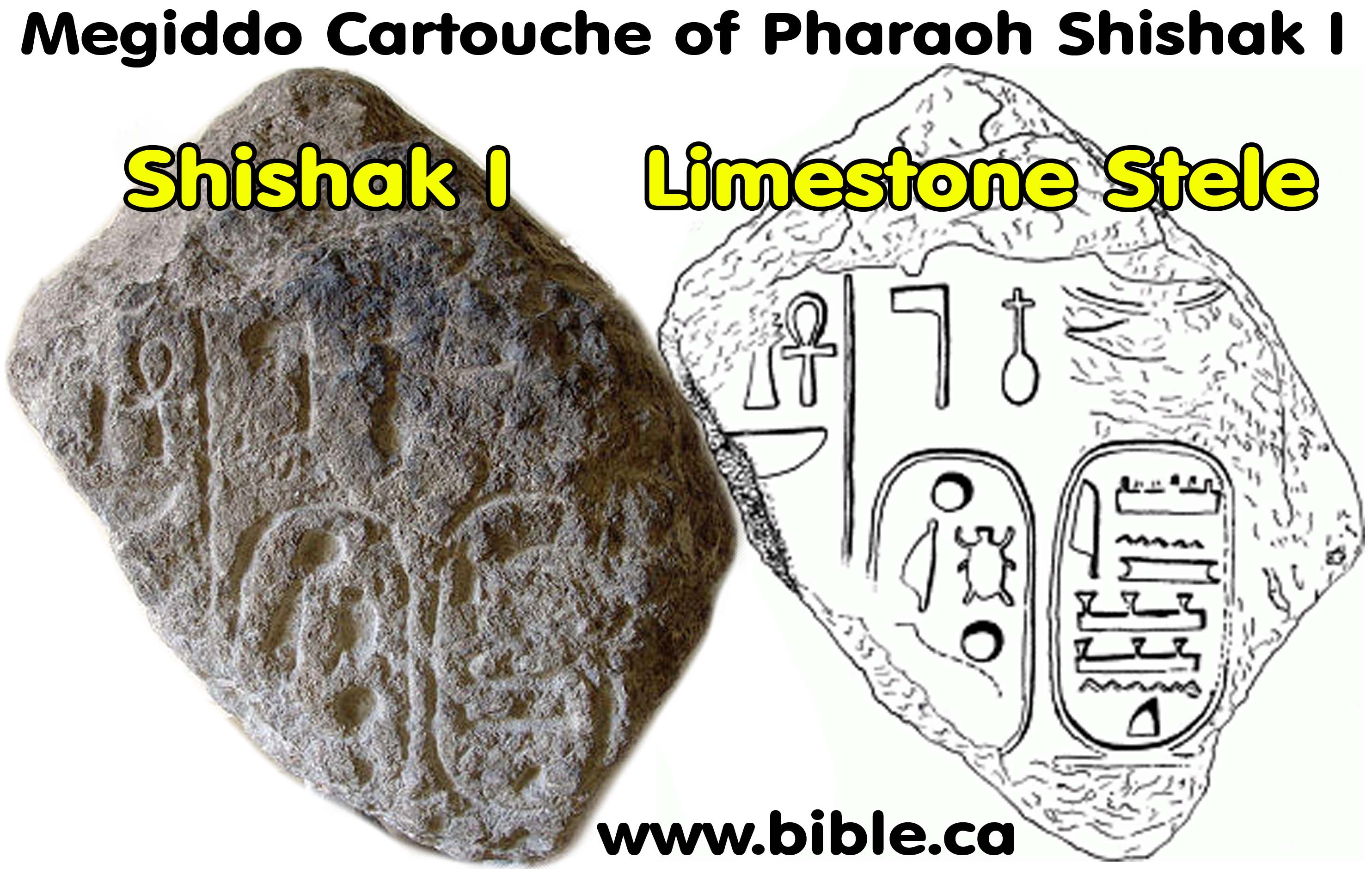
VI. The El-Hibeh Relief and Cartouche of Pharaoh Shishak I
- Pictured here is a relief of Shishak I and a temple block with carved cartouche of Sheshonq I at El-Hibeh, Egypt.
- The scene at El-Hibeh appears to be a fragmentary second account of the invasion of Shishak of Israel in 926 BC recorded at Karnak.
- "The small provincial temple at El-Hibeh was built of local limestone by Sheshonq I, first ruler of Dynasty 22. The decoration was evidently completed by his son, Osorkon I. Later, probably in Dynasty 30, a pronaos was added to the original Third Intermediate Period structure. … Surrounding the temple on three sides (north, east, south) are the remains of a once substantial mudbrick temenos wall, founded in places directly on limestone outcrop. … Relief decoration was still visible, but only in a few areas. The relief on the back exterior wall of the temple was badly worn and only barely legible in places. Some of the relief blocks in the interior were in better shape; in general the relief in the front of the temple seems to have been cut into better quality limestone and is therefore better preserved than that in the back of the temple. … Some of the relief blocks in the temple interior were still in situ on the temple walls. Others, large or very large, had fallen and were on or embedded into current the current ground surface level. One of these blocks preserved a very clear carving of a cartouche of Sheshonq I." (Report On The 2001 Fieldwork Season Of The University Of California Berkeley At The Archaeological Site Of El-Hibeh, Beni-Suef Governorate, Carol A. Redmount, Project Director)
- See map for location of El-Hibeh:
VII. Pharaoh Osorkon I gifts 383 tons of Solomon's gold and silver to the God's of Egypt in 921 BC!
1. The pillar in a temple at Bubastis that says Pharaoh Osorkon I gifted the modern equivalent of 383 tons of gold and silver to all the gods of Egypt in 921 BC.
a. "Directly after Shishak’s death, and less than a decade after Solomon’s death, Osorkon proudly recorded on a granite pillar in a temple at Bubastis, in the eastern Nile Delta, his own breathtakingly munificent gifts to the gods and goddesses of Egypt. These gifts were for “[all the gods and goddesses of the cities] of Upper and Lower Egypt, from Year 1 (of Osorkon’s reign) … to Year 4 … , making 3 years, 3 months and 16 days,” that is for the period from 924 to 921 B.C. Only fragments of this long and detailed hieroglyphic text of Osorkon have been found. But these seem to record gifts totaling approximately two million deben of silver, and 2,300,000 deben of gold and silver—at least 383 tons of precious metal given by Osorkon to the gods. The crowded lines of the main text give us details of rich gifts to each god or goddess: “What His Majesty gave to the Temple of Aman-re … a standing statue offering incense, … its body of beaten gold and silver, amounting to: gold, 183 deben, silver, 19,000 deben, black copper . … ” After the gifts to Re comes: “gold, lapis … 332,000 deben, total, 594,300 deben,” and so on. Where could Osorkon have obtained such immense wealth, to spend on such a scale after only three and a third years of his reign? Barely five years earlier, Osorkon’s father Shishak had looted the wealth of Jerusalem. It seems unlikely to be a mere coincidence that almost immediately after that event Osorkon could dispose so freely of so much gold and silver. The vast amounts of Solomon’s golden wealth may have ended up, at least in part, as Osorkon’s gift to the gods and goddesses of Egypt." (Where Did Solomon’s Gold Go?, Kenneth A. Kitchen, Bible and Spade, V7, p108, 1994 AD, reprinted from Biblical Archaeology Review 15/3, May, 1989, p.30)
b. "On another fragment from the pillar in the temple at Bubastis hieroglyphs indicate numbers—part of the tally of this vast gold treasure. Each upside down “U” stands for 10; each curl above them stands for 100. The “tadpoles” or “bird-shaped” figures at the bottom of the second column and at the top of the last column on the right represent 100,000 each, and the people with upraised arms are each symbols for 1,000,000." (Where Did Solomon’s Gold Go?, Kenneth A. Kitchen, Bible and Spade, V7, p108, 1994 AD, reprinted from Biblical Archaeology Review 15/3, May, 1989, p.30)
2. Obviously this large cache of precious metals came directly from the Jerusalem Temple and Solomon's palace as per 1 Kings 14:25-26 and 2 Chron 12:2-9.
a. "Now it happened in the fifth year of King Rehoboam, that Shishak the king of Egypt came up against Jerusalem. He took away the treasures of the house of the Lord and the treasures of the king’s house, and he took everything, even taking all the shields of gold which Solomon had made." (1 Kings 14:25-26)
b. "So Shishak king of Egypt came up against Jerusalem, and took the treasures of the house of the Lord and the treasures of the king’s palace. He took everything; he even took the golden shields which Solomon had made." (2 Chronicles 12:9)
3. What a stunning confirmation that the Bible is true!
VIII. Funerary artifacts from Pharaoh Shishak I and Shishak II
|
Bracelet found on the mummy of Shishak I. Gold inlaid with lapis lazuli, carnelian and faience with "magic eye". (Cairo Museum.) |
|
|
Solid Silver sarcophagus of Shishak II The large amounts of silver and gold in Egypt immediately after Shishak raided Jerusalem may show us the story in the Bible is true! |
|
|
The Great Sphinx of Tanis This sphinx was successively inscribed with the names of these Pharaohs: 1. Ammenemes II (1929-1895 BC) 2. Merneptah (1212-1202 BC) 3. Shishak I (945-924 BC). |
IX. Negev border fortresses of Solomon
|
|
|||
|
Introduction document: Solomon's network of military border fortresses |
|||
|
|
|||
- The Discussion of Shishak's invasion if Israel would not be complete without taking note of the series of fortresses that Solomon built on the border of Egypt.
- Introduction document: Solomon's network of military border fortresses
- Name rings #77, 87/88, 101/102, 107, 108/109, 110/111 etc are all fortresses in the Negev. Although unidentified, we know that there were several fortresses in the Negev at:
- Name ring #XI:4: ngrn? "well of the threshing floor" Ain Goren. (not likely Ekron)
- Possibly "Ain" Josh 19:7
- Possibly Ain Qudeirat the largest spring within 150 km radius in the Negev, misidentified as Kadesh Barnea since 1914 AD. However we know there was a fortress at Qudeirat that dates to the time of Solomon.
- The association with a threshing floor instead of the fortress would be puzzling it Ain Goren is actually Qudeirat.
- Name ring #123: Brrd, Beir Loz/Luz, Well of almonds, Borot Loz ponds.
- There was a fortress at Borot Loz that dates to the time of Solomon.
- While it is true that no fortresses have been found directly on the Darb Ghazza trade route, several have found on either side like Kuntillet Ajrud and Borot Loz ponds. "And above all, south of Qadesh Barnea along important Darb Ghazza, the main route to the Gulf of Eilat, not even one fortress has been found" ("Aharoni Fortress" near Quseima, Zeev Meshel, 1994 AD)
- "As for the distribution of the sites in the region, although many of the fortresses guard routes that might have been highways, one cannot postulate clearly drawn lines between identical way-stations built at regular intervals, as in the Nabataean spice road. … the Nabataean road see Meshel and Tsafrir 1974. The situation described by no means implies that there was no connection between the fortresses and roads (Finkelstein 1984: 190). The location of some fortresses, such as the Aharoni fortress and Nahal Loz, cannot be explained otherwise. (The "Aharoni Fortress" Near Quseima and the "Israelite Fortresses" in the Negev, Zeev Meshel, 1994 AD)
- The list of 15 cities fortified by Jeroboam did not include any Negev locations because this region had already been fortified by Solomon.
- The name rings of Shishak that reference fortresses almost certainly must refer to some of the fortresses Solomon built!
Conclusion:
A. There are seven historic witnesses to the invasion of Israel in 926 BC which show the Bible is real history!
- The Bible texts: 1 Kings 11:40; 14:25-26; 2 Chronicles 12:2-9
- The great relief scene at Karnak that lists 187 conquered place-names in Judah and Israel, 43 are known cities!
- The El-Hibeh Cartouche of Pharaoh Shishak I and the relief on the walls of the temple that give a second account (fragrmentary) of his great invasion of 926 BC.
- The stela from Megiddo with the cartouche of Shoshenq I on it.
- The stela at Karnak which documents a border-incident with Israel. "The incident might well have provided Shoshenq I with his excuse for raiding post-Solomonic Canaan, while his ultimate aim was much more." (The Campaign of Shishak, Shoshenq I, in Palestine, Kenneth A. Kitchen, Themelios, No. 3, Summer 2001, 26. Pages 44–46, 2001 AD)
- The pillar in a temple at Bubastis that says Pharaoh Osorkon I gifted 383 tons of gold and silver to all the gods of Egypt in 921 BC. Obviously this large cache of precious metals came directly from the Jerusalem Temple and Solomon's palace as per 1 Kings 14:25-26 and 2 Chronicles 12:2-9.
- A solid gold coffin which further evidences an abundance of gold taken from Jerusalem by Shishak.
B. Finding the name of David on name rings 105/106 at Karnak in Egypt that dates to 926 BC is a spectacular bonus!
C. Solomon knew his son Rehoboam was a fool:
- "Thus I hated all the fruit of my labor for which I had labored under the sun, for I must leave it to the man who will come after me. And who knows whether he will be a wise man or a fool? Yet he will have control over all the fruit of my labor for which I have labored by acting wisely under the sun. This too is vanity. Therefore I completely despaired of all the fruit of my labor for which I had labored under the sun." (Ecclesiastes 2:18–20)
- True to the proverb from Solomon's own mouth, penned shortly before he died, all of his gold, silver, wealth was pilfered by his son and ended up in Egypt when Shishak attacked Jerusalem and took the riches of the Temple and Palaces.
- The fact that Solomon married the Egyptian princess in the first two years of his reign and his participation in idolatry until just before he died, it is fitting that his wealth ended up being gifted to the pagan gods of Egypt by Shishak's son, Osorkon I.
By Steve Rudd: Contact the author for comments, input or corrections.

